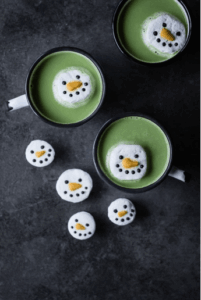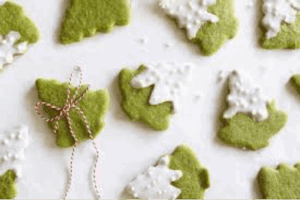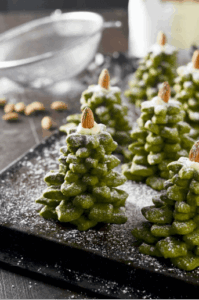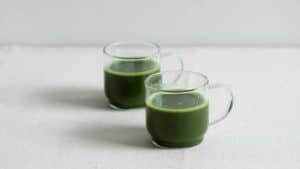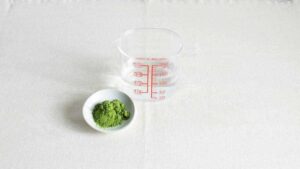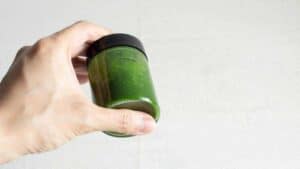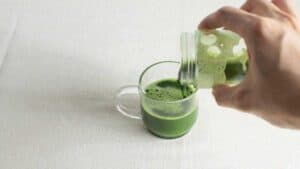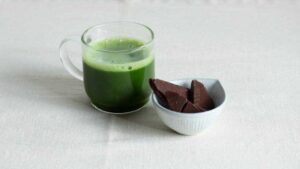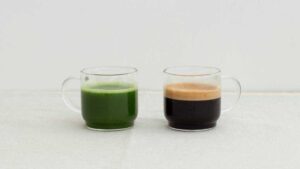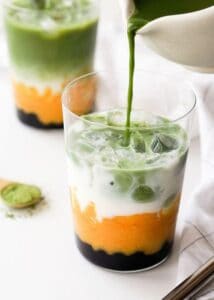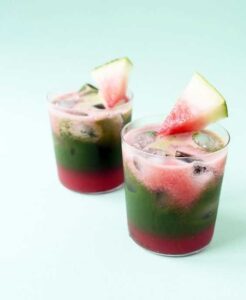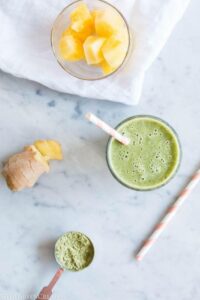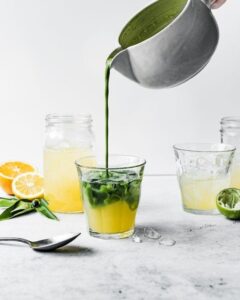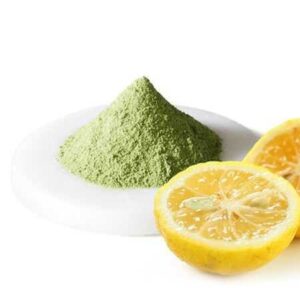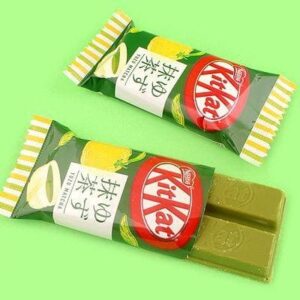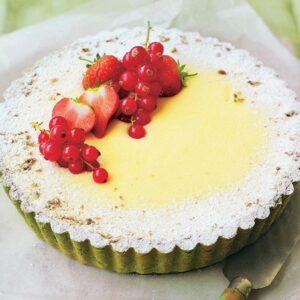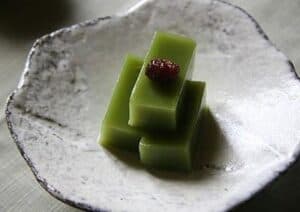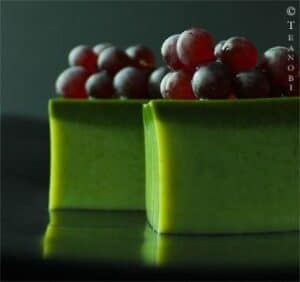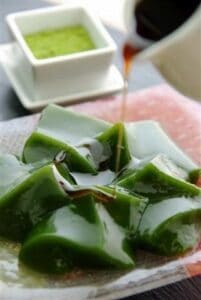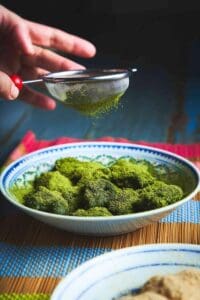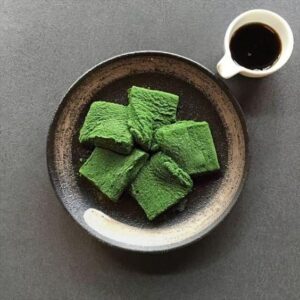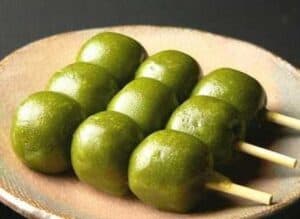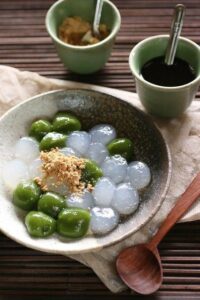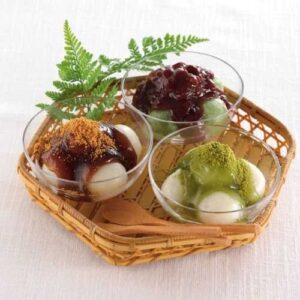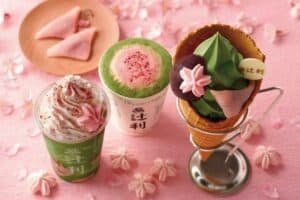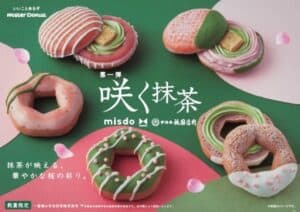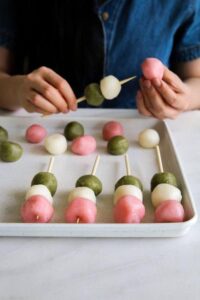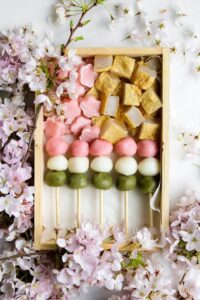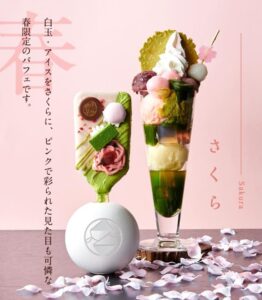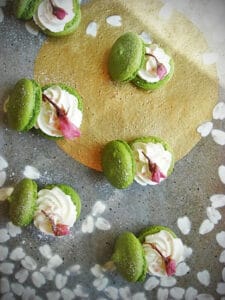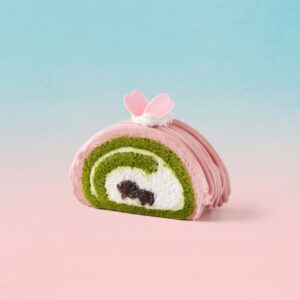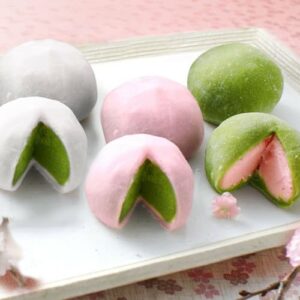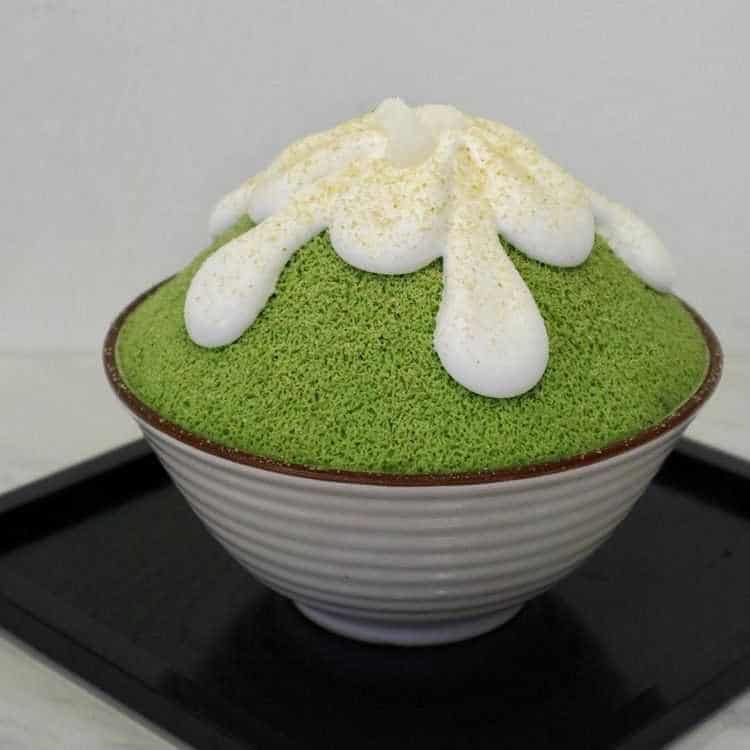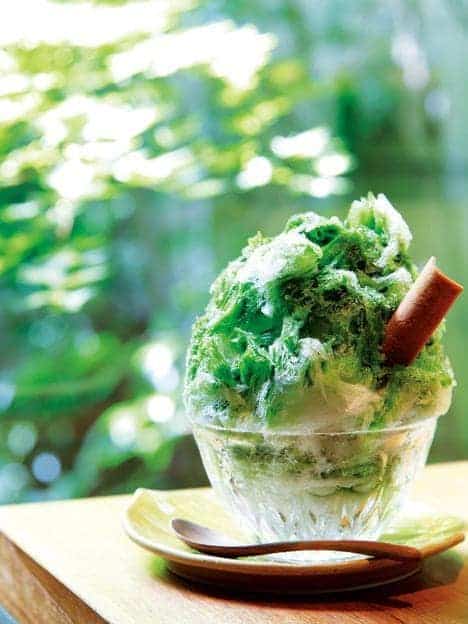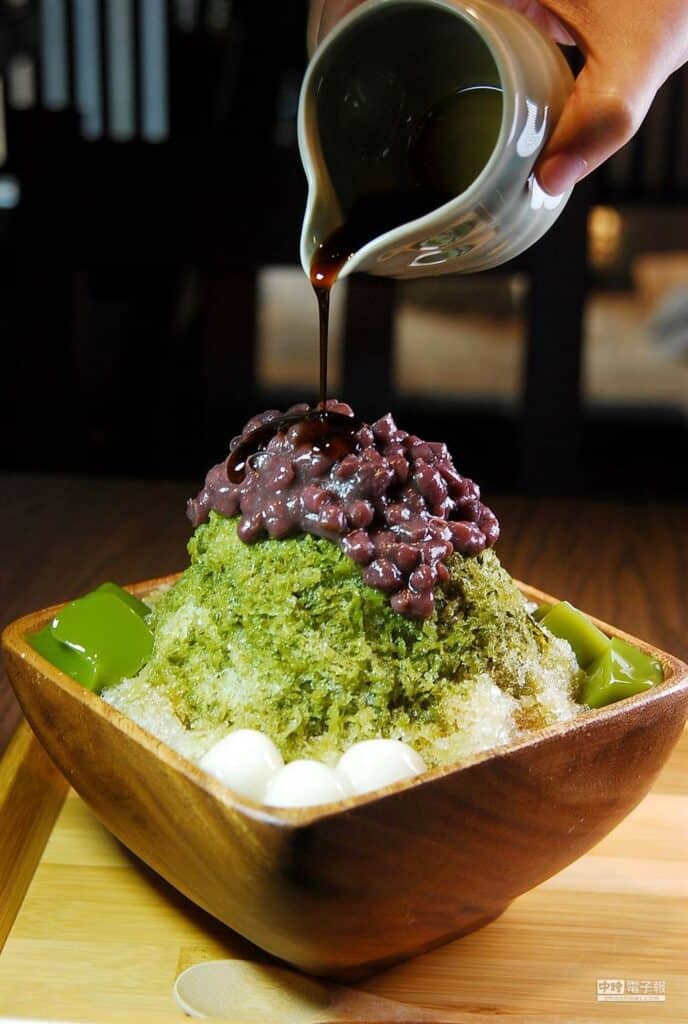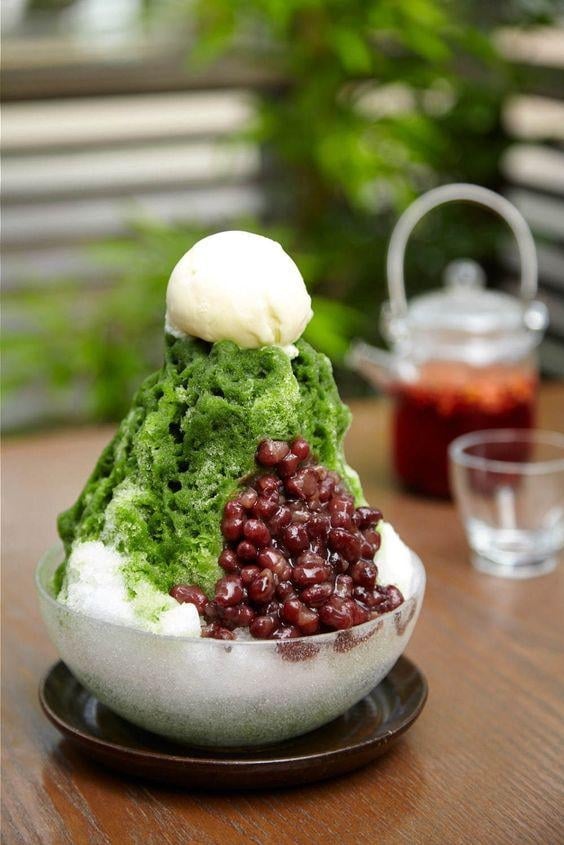Tag: #เมนูชาเขียว
Add some color to your tea menu for Christmas.
As the end of the year approaches, many restaurants are starting to release new menus to welcome the festive season, including drinks and bakery items. But if you’re still unsure of how to create your own menu, Matchazui has compiled ideas and recipes for green tea drinks and desserts, so that green tea lovers can try to change up their menus and make them more fun.
Let’s start with hot matcha latte, a recommended menu of many shops that adds color to the Christmas festival. It’s easy to eat by adding cute snowman marshmallows. The method is not difficult because we start by making square marshmallows according to the marshmallow recipe of the favorite shop. Make them large enough to cut into small rounds. Use a toothpick with one pointed end to break off and dip the toothpick into melted orange white chocolate and draw a nose on the marshmallow. For the eyes, put 2 tablespoons of dark chocolate chips and 1/4 teaspoon of coconut oil in a small plate and microwave in 20-second increments, stirring a little at a time, until the dark chocolate is completely melted and smooth. Use a pointed toothpick to dip into the melted dark chocolate and smear it on the snowman’s eyes and mouth. Let the snowman chocolate set at room temperature before serving with your favorite hot matcha latte.
Next up is the Matcha Cookie Christmas Tree. Start by beating 1 cup unsalted butter, 2 tablespoons matcha powder, and 1 ½ cups sugar until fluffy. Add 1 egg yolk and 1 teaspoon vanilla and mix until combined. Sift together the flour, baking soda, and salt and set aside in another bowl. Place all ingredients in a bowl and mix until combined. Cover the dough and refrigerate for 30 minutes. Preheat oven to 180 degrees. Line a baking tray with baking paper.
Cut dough in half or quarters and roll out to about 1/6 – 1/4 inch thick. Cut out Christmas tree molds and place on prepared baking sheet. Bake each batch for 7 – 9 minutes. Decorate with white chocolate, microwaved for 20 seconds, or mix in a little red chocolate for a different design.
The intensity of the Christmas tree color depends on the amount of matcha powder added. Add some cuteness by tying it with a bow or packing it in a clear plastic bag to show off the cookie pattern.
A technique to make Christmas cookies more cute is when pressing the dough into the shape of a Christmas tree. You can press it into the shape of stars of various sizes so that after baking, you can arrange them in alternating layers, with each layer connected with a little white chocolate. Stick the star on top with almonds and sprinkle a little icing. You’ve got a green tea cookie menu for this Christmas season.
Another menu that just seeing it makes you think of a Christmas tree is Matcha Mont Blanc. You can use the regular Mont Blanc recipe, but just replace the chestnut cream on top with green tea cream and decorate with colorful icing cookies. It becomes a green tea Mont Blanc that will impress anyone who eats it.
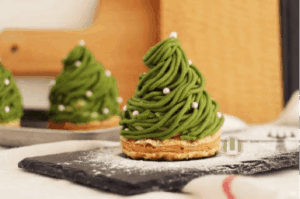
In addition to the tea menu above, which is a sample to give your tea shop some initial ideas for customizing their menu, there are many other green tea menus that can be sold during Christmas, such as Matcha Hot Chocolate or Matcha Macaron, or even Matcha Cake, which emphasizes red color with strawberries.
But if you’re not good at making desserts that require a lot of techniques, try adapting the no-bake green tea dessert menu (see more at shorturl.at/dpDS7) into a Christmas style. It’s another interesting idea. Especially if there are new menus and year-end campaigns with interesting promotions or activities, it will encourage customers to visit the shop even more (see more at shorturl.at/ceqKP). Because it’s not necessary for every shop to launch new menus during this festival. It might be difficult for some shops to always come up with new menus. Because according to Japanese belief, simply buying green tea to give to each other during various festivals is considered a blessing for good health (see more at shorturl.at/bcCHK).
Source
https://encha.com/pages/matcha-recipes
https://www.stephaniesuen.com/2018/12/08/mini-matcha-christmas-tree-sugar-cookies/
https://steemit.com/food/@alwayssmile/elegant-noble-french-dessert-mont-blanc
https://hostthetoast.com/matcha-cookie-christmas-tree-stacks/
Mastering the Art of Adding a Matcha Shot to Your Beverage
เวลาสั่งกาแฟ จะเห็นว่าในเมนูบางร้าน นอกจากเมนูกาแฟปกติ ก็จะมี option เพิ่ม Espresso shot อยู่ในนั้นด้วยเพื่อเอาใจคนชอบดื่มแบบเข้มๆ แต่ถ้าเป็นเมนูชา ไม่ว่าจะเป็นชาเขียว ชาโฮจิฉะ หรือชาไทย เราแทบจะไม่เห็นการเพิ่มช็อตชา เพื่อให้ชามีความเข้มข้นมากขึ้น ซึ่งจริงๆแล้ว ในต่างประเทศมี Option เพิ่มช็อตชา หรือแม้กระทั่งการขาย Matcha shot เหมือนการขาย Espresso shot ก็มีเช่นกัน ซึ่งมีประโยชน์ต่อสุขภาพพสมควรเลยทีเดียว แต่คนไทยจะไม่ค่อยคุ้นชินกับการดื่มชาเป็นช็อตแบบนี้
หากใครเป็นคนที่รักการดื่มชาเขียว จะพอทราบว่าการชงชาเขียวตามแบบฉบับคนญี่ปุ่น จะมีการชงแบบ Usucha และ Koicha ( ดูรายละเอียดเพิ่มเติมได้ที่ https://bit.ly/2RrD29N ) ซึ่งการทำ Matcha Shot ก็เป็นการดื่มที่เกิดขึ้นจากการที่ผู้คนพยายามหาวิธีการใหม่ๆ เพื่อให้ได้ลิ้มรสของชาเขียวเข้มข้น
ซึ่งความน่าสนใจของ Matcha shot คือ อัตราส่วนของน้ำต่อมัทฉะที่ใช้ในการชงนั้นใกล้เคียงกับ Usucha เพราะ Matcha shot ประกอบไปด้วยผงมัทฉะ กับน้ำร้อนเท่านั้น
ผงมัทฉะชนิดใดที่คุณควรใช้ในการทำ Matcha Shot ?
แนะนำเป็นเกรดพิธีการ ( Ceremonial Grade ) เพราะ Matcha shot มีจุดเด่น คือ รสชาติและสีของชา ซึ่งจะมาจากคุณภาพของผงมัทฉะล้วนๆ เพื่อให้ได้ Matcha shot ที่สีเขียวสดใส และ รสขมที่ชัดจากผงมัทฉะเพียวๆ การเสิร์ฟ Matcha shot ตามมาตรฐานคือ
ผงมัทฉะ 1 ช้อนชาหรือ 2 กรัม กับน้ำ 70 – 100 ม.ล. โดยน้ำมีอุณภูมิอยู่ที่ 80 องศาเซลเซียส หากเป็นน้ำที่เพิ่งต้มเดือดๆเลย แนะนำเป็นให้วางทิ้งไว้สัก 5 นาทีเพื่อให้อุณหภูมิน้ำลดลง
หลังจากเทน้ำผสมกับผงมัทฉะแล้วให้ปิดฝาขวดแล้วเขย่าประมาณ 30 วินาที หรือจนกว่าผงมัทฉะจะละลาย เสิร์ฟเป็น Matcha shot ได้เลย แต่ถ้าใครที่ถนัดกับการใช้ฉะเซ็นตี ก็สามารถทำได้เช่นกัน
อย่างไรก็ตาม Matcha shot อาจจะไม่เหมาะสำหรับทุกคน โดยเฉพาะผู้ที่เพิ่งเริ่มหัดดื่มชาเขียว เพราะ Matcha shot จะมีความเข้มข้นกว่ามากในช่วงแรกที่ดื่ม ( คล้ายกับดาร์กช็อกโกแลต 70% ) หลังจากนั้นไม่กี่วินาทีความเข้มข้นนั้น จะเปลี่ยนเป็นรสอูมามิที่ค้างอยู่ในคอ และมีรสชาติชาขมๆค้างอยู่ในปาก หากเพิ่งเริ่มดื่มมัทฉะแนะนำให้ดื่มเป็นมัทฉะลาเต้ หรือเป็นมัทฉะเพียวแบบเย็นจะดื่มง่ายกว่า
หากถามว่าการดื่ม Matcha shot กับ Espresso shot แบบไหนได้คาเฟอีนที่มากกว่ากัน สังเกตได้จากปริมาณคาเฟอีนในมัทฉะขึ้นอยู่กับปริมาณผงมัทฉะที่คุณใช้ ผงมัทฉะ 1 ช้อนชาจะมีคาเฟอีนประมาณ 70 มก. ดังนั้น Matcha shot จะมีคาเฟอีนประมาณ 70 มก. หากเปรียบเทียบกับ Espresso shot ในปริมาณที่เท่ากัน Espresso shot จะมีคาเฟอีนอยู่ที่ประมาณ 80 มก.
ความแตกต่างที่สำคัญระหว่าง Espresso shot และ Matcha shot คือ คาเฟอีนใน Matcha shot จะถูกปล่อยออกมาอย่างช้าๆเนื่องจากมีแอล – ธีอะนีน นั่นหมายความว่า แม้ว่าเครื่องดื่ม 2 ชนิดจะมีคาเฟอีน แต่ Espresso จะมีคาเฟอีนอยู่ในร่างกายเพียง 1 ชั่วโมงเท่านั้น ดังนั้นหากใครที่อยากให้คาเฟอีนอยู่ในร่างกายได้นานขึ้น เพื่อให้มีสมาธิ และช่วยให้สงบนิ่งมากขึ้น แนะนำเป็นให้ดื่ม Matcha shot แทนจะดีกว่า
Matcha shot เป็นเครื่องดื่มชาเขียวที่มีคุณค่าทางโภชนาการค่อนข้างสูง จึงแนะนำให้ดื่มทันทีที่ชงเสร็จ เพื่อความสดใหม่ และเพื่อเพิ่มพลังงานได้ในทันทีหลังจากดื่ม จึงเหมาะกับการดื่มในเช้าวันใหม่ หรือเมื่อรู้สึกเหนื่อยล้าจากการทำงานหนักมาตลอดทั้งวัน หรือจากการนอนไม่เพียงพอ การดื่ม Matcha shot จะช่วยให้รู้สึกกระปรี้กระเปร่าขึ้น เพราะการทำ Matcha shot ถูกดัดแปลงวิธีการชงให้ชงง่ายรวดเร็ว และเพื่อให้ดื่มได้ง่ายๆเพื่อรีบูสความสดชื่นในร่างกาย ทำให้บางคนที่อยากได้คุณค่าทางสารอาหารเต็มๆ
มาเริ่มต้นเช้าวันใหม่ ด้วย Matcha shot อุ่นๆสักแก้ว ดีมั้ยคะ 🙂
ที่มา
https://naokimatcha.com/recipes/matcha-shot/
http://hungarianhousewife.com/afternoon-boost-matcha-shot
บทความจาก : Fuwafuwa
Add some freshness to your life with Matcha Fruity
During this time, there are many seasonal fruits. Many shops that sell sweets and food will have fun creating new menus to match the festival. But for green tea shops, I believe that there must be many shops that feel that it is difficult to mix these delicious fruits with tea menus at the shop. Today, Matchazuki is sharing the idea of matcha fruity… paired with green tea and fruits such as mango, watermelon, pineapple, to create new menus at the shop, creating freshness, brightness, and as an idea for many people who are looking for drinks to refresh themselves during the day to try doing it.
Start with Mango Green Tea with Bubbles , which gets its sweetness from brown sugar coating the bubbles and from ripe mangoes instead of syrup. The bubbles can be bought ready-made or you can boil them yourself. We will put the bubbles at the bottom of the glass, followed by ½ cup of mango puree, fill the glass with ice and pour ½ cup of milk as the third layer. After that, brew the matcha in another teacup with 1 teaspoon of matcha powder and ¼ cup of water. Beat it with cha sen until it is blended, then pour the whipped green tea into the glass that was prepared earlier. It is done.
For those who do not want to buy ready-made mango puree, you can buy ripe mangoes and cut them into small cubes instead. Or you can use frozen ripe mangoes and roughly blend them with a little water, depending on the consistency you want. The size of the mangoes you cut will give you a better texture.
The next menu is so strange that it may not be able to imagine the taste for many people, but I recommend you try it. It is a watermelon green tea. It is a recipe without milk. It tastes like drinking pure green tea, but with a hint of watermelon to reduce the bitterness of the green tea and add sweetness from watermelon instead.
Start by blending 2 cups of watermelon and pour it into the bottom glass about ⅓ full. Fill the glass with ice. Then pour the green tea, made with 1 teaspoon of matcha powder, whipped with ¼ cup of hot water, over the watermelon. Pour the remaining blended watermelon juice over the glass. Garnish with watermelon slices for decoration.
The next recommended menu is Pineapple Green Tea , which is also sold at the famous coffee shop Starbucks. It is also a non-diary menu that is very refreshing.
How to make it is very easy, just take 1 teaspoon of matcha powder + 5 ounces of pineapple juice + ⅛ teaspoon of ginger + ¼ cup of coconut milk + 1 teaspoon of sugar + 6 ounces of cold water. After blending, pour it into a glass with prepared ice and it’s done.
A sour and refreshing menu that helps refresh the fatigue from staring at the computer all day is honey lemon green tea. Use ½ teaspoon of matcha powder, beat with 2 tablespoons of hot water, then add 3 tablespoons of honey and stir until dissolved. After that, pour into a glass with ice, followed by ½ cup of soda and 2 teaspoons of lime or lemon juice. Garnish with lemon or mint leaves and you’re done. But when drinking, it is recommended to stir it well before drinking for a harmonious taste.
And the last fruit is Yuzu, which is quite expensive in Thailand, but in Japan it is popularly used in snacks and drinks. Kit Kat also does not miss out on using Yuzu, an orange with a unique refreshing scent and a sour taste like lemon, in snacks to add interest and novelty to the product.
However, finding whole yuzu can be quite difficult and expensive. Currently, there are many companies in Thailand that sell pure yuzu juice for making desserts or drinks. You can buy it at bakery supply stores or directly from the company’s page.
Let’s take a look at the tea and yuzu menu… The yuzu green tea menu is a menu that many shops already have as part of their menu. The method of making it is similar to the green tea lemon soda. But another idea that is worth trying and is quite new is the yuzu hojicha latte.
In this recipe, we will add 2 tablespoons of yuzu marmalade to the bottom layer, followed by ½ cup of ice, then slowly pour in 200 ml of milk. Then, beat in 2 teaspoons of hojicha powder with 100 ml of hot water. Let it melt together and pour it on top to create 3 beautiful layers as shown in the picture.
However, yuzu can be used to make other types of sweets with matcha powder, making many other delicious desserts, such as yuzu green tea cheesecake, yuzu green tea tart, or green tea mousse served with yuzu macarons.
Staying home for a long time, try opening the stove, going into the kitchen, grabbing this and that, and you’ll get a bunch of new, delicious menus. Because green tea tastes good with anything. See recipes for desserts and other green tea drinks at https://bit.ly/2QYsheW
Source
https://www.davidstea.com/us_en/tea/yuzu-matcha/10812US01VAR0059386.html
https://kumikomatcha.fr/blogs/recettes/entremet-yuzu-matcha
https://hojicha.co/blogs/recipes/yuzu-hojicha-latte
https://www.hola.com/cocina/recetas/2014081873169/tarta-yuzu-te-matcha/
Article from: Fuwafuwa
Enhancing Japanese Desserts: Matcha Powder with Three Classic Toppings
“โยคัง วาราบิโมจิ ดังโงะโมจิ” ขนมญี่ปุ่น 3 ชนิดนี้ เห็นได้ทั่วไปในร้านขนมญี่ปุ่น บางร้านก็เสิร์ฟแบบเดี่ยวๆ บางร้านก็เสิร์ฟคู่ชาเขียวร้อนๆ ตามร้านคาเฟ่ จะถูกนำมาเป็นท้อปปิ้งบนพาร์เฟต์ ไอศครีม หรือน้ำแข็งใส เพื่อให้ขนมจานนั้นได้กลิ่นอายและสัมผัสรสชาติความเป็นญี่ปุ่น
ในปัจจุบันได้มีการดัดแปลงปรับสูตรให้รสชาติของขนมทั้ง 3 ชนิดนี้มีความหลากหลายมากยิ่งขึ้น และมีวิธีจัดเสิร์ฟแบบทันสมัยแต่ได้กลิ่นอายความเป็นวากาชิ หรือขนมญี่ปุ่น หลากหลายไอเดียและวิธีทำขนมแบบง่ายๆให้คนรักมัทฉะเอาไปปรับสูตรทำเองที่ร้านได้
เริ่มจาก “โยคัง”(羊羹) โยคังเป็นวุ้นถั่วแดงกวน ปกติจะมีรูปทรงเป็นแท่งสี่เหลี่ยมผืนผ้า สีน้ำตาลแดงจากถั่วรสชาติหวานจัด ส่วนใหญ่จะทานคู่กับชาเขียวร้อนในพิธีชงชารสชาติจะตัดกัน เดิมทีมีต้นกำเนิดมาจากประเทศจีน เป็นขนมที่ทำด้วยเจลาตินจากเนื้อแกะ ในยุคคามาคุระมีนักบวชศาสนาพุทธนิกายเซน เป็นผู้นำขนมโยคังเข้ามาเผยแพร่ในญี่ปุ่น แต่เนื่องจากศาสนาพุทธห้ามการฆ่าสัตว์ จึงมีการเปลี่ยนจากเจลาตินจากสัตว์ มาเป็นแป้ง ถั่วแดง และวุ้น และมีการใช้วุ้นเข้ามาผสมในภายหลัง จนกลายมาเป็นโยคังในปัจจุบัน
โยคังเป็นวุ้นญี่ปุ่นซึ่งมีต้นกำเนิดมาจากประเทศจีน มีลักษณะเป็นก้อนสี่เหลี่ยมสีน้ำตาลแดงโดยทำจากถั่วแดงกวน (Anko) ถ้าเป็นโยคังสีเขียวก็ทำจากชาเขียว ที่มีวิธีทำแสนง่าย
- นำถั่วแดงบดเนื้อเนียน 225 กรัมและน้ำตาลทรายขาว 70 กรัมผสมลงในหม้อ นำไปต้มด้วยไฟกลาง คอยคนตลอดด้วยไม้พายเพื่อไม่ให้ไหม้
- ต้มไปซักพัก แล้วลองลากไม้พายลงไปตรงกลางแล้วยังเหลือเป็นรอยลาก คือถั่วแดงไม่ไหลกลับมากลบรอยก็ถือว่าโอเค จากนั้นตักออกมาแผ่บนถาดเพื่อให้เย็นลง
- ในหม้อต้มอีกใบผสมน้ำ 180 มล. + ผงชาเขียว 5 กรัม กับผงวุ้นหรือผงคันเทน 2 กรัม ต้มจนเดือดแล้วจึงลดเป็นไฟเบา ต้มต่ออีก 2 นาทีแล้วจึงปิดไฟ
- ผสมน้ำตาลทรายแดง 20 กรัม และ (2) ลงไปใน (3) ผสมจนเข้ากัน นำไปต้มจนเดือดแล้วจึงลดเป็นไฟเบา ต้มต่ออีก 2 นาที
- เทใส่พิมพ์แล้วนำไปแช่เย็น 30 นาที เอาออกมาหั่นเสิร์ฟเป็นชิ้นๆ อาจเสิร์ฟคู่กับถั่วแดงเชื่อมด้านบน
คุณสมบัติอีกอย่างที่คาดไม่ถึงของขนมโยคัง คือ เก็บไว้ได้นาน อย่างเช่นมากถึง 5 ปี 6 เดือน เพื่อสามารถเก็บเป็นอาหารยามฉุกเฉินเวลามีเหตุภัยพิบัติธรรมชาติ นอกจากนี้ร่างกายยังดูดซึมสารอาหารได้ง่าย และเก็บไว้ในอุณหภูมิปกติได้แม้ไม่ได้นำเข้าตู้เย็น
ส่วน” วาราบิโมจิชาเขียว “เป็นขนมญี่ปุ่นที่ทำด้วยแป้งจากต้นวาราบิ เนื้อแป้งหนึบ ๆ คล้ายกับแป้งโมจิ นิยมนำไปคลุกกับ คินาโกะ (Kinako) ซึ่งเป็นผงถั่วเหลืองได้กลิ่นหอม ๆ แบบถั่วคั่ว หรือทานคู่ซอสน้ำตาลทรายแดง เรียกว่า คุโรมิสึ (Kuromitsu) หรือโรยผงชาเขียว ก็เป็นขนมที่ได้รับความนิยมมากๆ ในช่วงหน้าร้อน ตามร้านคาเฟ่จะมีวาราบิโมจิเป็นท้อปปิ้งบนพาร์เฟต์ ไอศครีม วิธีทำก็ไม่ยาก เริ่มจาก
- ผสมแป้งวาราบิโมจิเขียว100 กรัม นํ้าตาล 50 กรัม ผงมัทฉะ 1 ช้อนชา นํ้าเปล่า 500 มล. ในอ่างผสม
- เอาหม้อใส่นํ้าต้มให้เดือด วางอ่างผสมลงไปด้านบน กวนไปเรื่อยๆ พอแป้งเริ่มสุก ก็ยกลงกวนต่อจนแป้งสุกและใสทั่ว เป็นเนื้อเดียวกัน โรยผงถั่วบนถาดหรือภาชนะที่จะใช้ใส่วาราบิโมจิ เสร็จแล้ววางในอ่างที่ใส่นํ้าแข็ง ทิ้งไว้ให้เย็นและเซ็ตตัว ประมาณ 20 นาที
- เทออกมาหั่น สังเกตจากแป้ง แป้งจะนุ่ม ใส และไม่คงรูป หั่นแล้วไม่เป็นชิ้นสี่เหลี่ยมลูกเต๋าเป็นเพราะแป้งนุ่มมากๆ ทำเสร็จแล้วรีบทานให้หมด
- หากใครอยากทานกับน้ำตาลคุโรมิทสึ ให้เอาน้ำตาลดำ หรือน้ำตาลทรายแดงบ้านเรา 50 กรัม ต้มละลายกับน้ำ 200 มล. ปริมาณน้ำขึ้นอยู่กับความหวานที่ต้องการ เพียงเท่านี้ก็เหมือนได้ไปคาเฟ่ที่ญี่ปุ่นเลย
ขนมตัวสุดท้าย “ดังโงะโมจิชาเขียว” ขนมที่ทำจากแป้งโมจิ ปั้นเป็นก้อนกลมๆ รสชาติเค็มๆ แต่ก็มีบางสูตรอาจเติมเนื้อเต้าหู้เข้าไปผสมด้วย แล้วนำไปนึ่ง หรือ ต้มในน้ำเดือดจนสุกก่อน ย่างบนเตาถ่าน ก่อนจะราดด้วยสารพัด หน้าต่างๆ เช่น โชยุ มิโสะ ถั่วแดงกวน มันเทศหวาน งาดำบด หรือ ซอสชาเขียว ด้วยรสสัมผัสนุ่ม หนุบหนับ ทำให้เป็นที่ชื่นชอบของคนส่วนใหญ่ แม้วิธีการเสิร์ฟจะเปลี่ยนไปแค่ไหน แต่ขนมดังโงะก็ยังถือได้ว่าเป็นขนมที่ได้รับความนิยมมาโดยตลอด เพราะเป็นสิ่งที่สะท้อนถึงขนบธรรมเนียมและประเพณีอันเก่าแก่ในอดีตของญี่ปุ่นมานับร้อยๆปี มาลงมือทำดังโงะตามสไตล์คนรักชาเขียวกันดีกว่า โดยสามารถผสมผงชาเขียวลงไปในแป้งเลยก้ได้เพื่อให้ได้แป้งสีเขียว หรือที่เห็นกันทั่วไปจะทำเป็นลูกสีขาวธรรมดา แต่ตกแต่งด้วยท้อปปิ้ง หรือซอสแบบต่างๆ
- เริ่มจากผสมแป้งข้าวเหนียว 100 g. แป้งข้าวจ้าว 100 g. และน้ำตาล 2 ช้อนชา เข้าด้วยกัน
- เติมน้ำ ⅔ ส่วน ในส่วนผสม ค่อยๆนวดจน เป็นเนื้อเนียน แล้วปั้นแป้งเป็นก้อนๆ เล็กใหญ่ตามต้องการ
- ค่อยๆย่อนลงต้มในน้ำเดือด ประมาณ 1 นาที หรือจนตัวดังโงะลอยขึ้น จากนั้นตักขึ้นแล้วนำมาน็อคด้วยน้ำเย็นจัด
- ปล่อยให้สะเด็ดน้ำแล้วนำมาเสียบไม้ แล้วนำไปย่าง ประมาณ 4 นาทีแล้วเอาขึ้น
- ส่วนน้ำซอสหรือท้อปปิ้งที่ใช้ราดดังโงะ สามารถดัดแปลงได้ตั้งแต่ใช้ถั่วขาวผสมผงชาเขียว หรือราดด้วยซอสมิทาราชิ ที่ทำจากน้ำตาล 5 ช้อนโต๊ะ + ซอสถั่วเหลือง 1 ช้อนโต๊ะ + มิริน 1 ช้อนโต๊ะ + น้ำเปล่า 5 ช้อนโต๊ะ + แป้งข้าวโพด 1 ช้อนโต๊ะ เคี่ยวจนเข้ากัน หรือจะทานคู่กับไอศรีมชาเขียวก็เป็นมื้ออร่อยของเด็กๆอย่างแน่นอน
ที่มา
http://kyotofoodie.com/kyoto-cafe-jouvencelle-gion/
https://www.flickr.com/photos/bananagranola/2529983071
บทความจาก : Fuwafuwa
Sakura & Matcha : A Perfect Match for Spring
Around this time of year, many people probably think of the pink cherry blossoms in full bloom, enjoying Japanese sweets and sipping on warm tea. Throughout Japan, there are new sweets with cherry blossom ingredients in almost every shop.
In particular, pairing it with a green tea menu helps to bring out the flavor and mellowness of Sakura perfectly, such as Sakura green tea soft cream, Sakura green tea latte, or donuts that use Sakura as an ingredient in the glaze that coats the donuts. It is an adjustment from the original recipe that is not difficult and can be made for every festival. However, the fun of immersing yourself in such an atmosphere this year will be difficult due to the COVID-19 outbreak. Matchazuki is pleasing those who miss Japan with a dessert recipe that is easy to make and has a Sakura scent.
Start with “Green Tea Mochi Pancakes with Sakura White Bean and Red Bean Filling”
Just pour 150 cc. of water into 30 grams of mochi flour or glutinous rice flour and mix until well blended. Then sift 30 grams of cake flour and add 2 grams of matcha powder and 2 tablespoons of sugar. Mix until well blended. Refrigerate for about 30 minutes.
After that, spread a thin layer of oil on a warm pan. Scoop the prepared dough and spread it into an oval shape. Fry over low heat until both sides are cooked. Fill with mashed white beans mixed with 2 grams of sakura powder or adjust the taste level as you like. If you make a filling with a mild sakura flavor, it is recommended to wrap it with pickled sakura leaves and decorate it with another layer of pickled sakura flowers.
The next recommended menu is “Hanami Dango”, 3 colors of Dango: green, white, and pink. This Dango is popularly eaten during the cherry blossom season while viewing the flowers. Many people believe that the 3 colors of Dango represent the blooming of the cherry blossoms, with green representing cherry leaves, white representing cherry blossoms that are in bud, and pink representing cherry blossoms that are in full bloom.
Let’s go into the kitchen and start cooking…
Start by dividing the kneading bowl into 3 bowls.
- Bowl 1: Take 40 grams of mochi flour, 40 grams of tofu, 1 tablespoon of sugar, and 2 grams of sakura powder and knead until soft.
- Next, in the second bowl: Take 40 grams of mochi flour, 40 grams of tofu, 1 tablespoon of sugar, and 2 grams of matcha powder and knead until soft. Some shops use mochi flour mixed with yomogi (yomogi is a type of Japanese grass that smells and tastes like vegetables. It is popularly used to make wagashi).
- The last part, 3rd bowl: Take 40 grams of mochi flour, 40 grams of tofu, 1 tablespoon of sugar and knead until soft. Then boil water and put the dango flour in and boil until the dango floats to the surface (about 2-3 minutes). Use a whisk to scoop them out of the boiling water and rinse with water to cool the dango. Then set aside. Use a skewer to insert the dango. 3 pieces per skewer and it’s ready to eat.
In Japan, Hanami Dango is popularly used as a topping for green tea parfait or green tea soft cream, making a perfect combination.
Next up is “Green tea Sakura red bean crepe cake” made with green tea chiffon cake, alternating layers with fresh cream, red beans and sakura crepe. The method for making sakura crepe is no different from making regular crepe cake. Beat 4 eggs together and add ⅓ cup of sugar and stir until dissolved. Sift 2½ cups of wheat flour with 2 tablespoons of sakura powder. After that, slowly pour 400 ml. of milk into the flour, dividing it into 3-4 rounds and stirring until there are no flour lumps left.
Add ¼ cup melted butter, mix well. Strain all ingredients and refrigerate the batter for at least 4 hours. When the time is up, stir the batter before frying. Grease a Teflon pan with butter and use low heat. Pour the batter into a circle. You will see that the batter is cooked when there are large air bubbles pushing the batter. Fry until all the batter is gone. After resting the batter by refrigerating it for about 2-4 hours, you can assemble the layers into a green tea sakura crepe cake. As for the method of making green tea cake, you can use this Matchazuki green tea cake recipe or if any shop has its own recipe, you can mix it (read the green tea cake recipe at shorturl.at/abuR5). Then change the cake mold to the same size as the sakura crepe you are making and it is done.
As you can see, Sakura used in making desserts is either Sakura powder extracted from pickled Sakura or pickled Sakura flowers. It depends on which one you choose. And in addition to the dessert recipes above that allow us to experience the perfect harmony of green tea and Sakura, a delicious pair, there are many other menus that can use Sakura to enhance the deliciousness and give a sense of this Seasonal, such as Green Tea Macarons with Sakura Fresh Cream, Green Tea Roll Cake with Sakura Fresh Cream, or like the popular dessert Daifuku, which perfectly combines Green Tea and Sakura.
Source
http://paogohan.blog42.fc2.com/blog-entry-513.html
https://www.travelsintranslation.com/2015/04/recipe-of-the-month-cherry-blossom-sugars/
https://arigatojapan.co.jp/sakura-and-matcha-a-perfect-match-for-spring/
https://soranews24.com/2021/03/11/sakura-and-matcha-star-in-new-mister-donut-collection/
https://nagoyafoodie.com/soft-serve-ice-cream-in-japan/
https://constellationinspiration.com/2020/04/dango-mochi.html
Article from : Fuwafuwa
Green tea bingsu & kakigori, easily delicious at home
เชื่อว่าพอเข้าหน้าร้อน ขนมที่ทุกคนต้องนึกถึงคงหนีไม่พ้น น้ำแข็งใส หรือในภาษาญี่ปุ่น ที่เรียกว่า คากิโกริ ซึ่งกล่าวกันว่า การกินน้ำแข็งไสมีมาตั้งแต่สมัยเฮอัน (Heian Period) โดยในสมัยนั้นจะเอาน้ำแข็งก้อนที่ได้จากธรรมชาติมาฝนด้วยมีดและเหล็กจนกลายเป็นเกล็ด แล้วนำมากินคู่กับน้ำหวานจากผลไม้และดอกไม้ ซึ่งลักษณะเด่นของคากิโกริ คือ เกล็ดน้ำแข็งของคากิโกริจะมีความละเอียดนุ่ม ส่วนใหญ่จะไม่มีรสชาติ แต่จะเน้นการเติมนมหรือไซรัปรสชาติต่างๆ เพื่อให้มีความหวานหอมจัดจนทั่ว ด้านบนนิยมเป็นครีมรสชาติต่างๆ ตกแต่งด้วยผลไม้สด หรือเผือกกวน ถั่วกวน ส่วนข้างในก็จะมีไส้ความอร่อยซุกซ่อนอยู่ตามแต่จะครีเอต ราดด้วยซอสรสต่างๆ มาเพิ่มรสชาติ
ส่วนบิงซูของชาวเกาหลีที่ได้รับวัฒนธรรมการกินจากชาวญี่ปุ่น คือ น้ำแข็งไส ที่มีลักษณะเด่นๆ คือ ต้องมี 3 ส่วนผสมหลัก ได้แก่ ถั่วแดง แป้งต๊อก (เค้กข้าวเกาหลีสีขาวเหนียวๆ ) และผงแป้งที่ทำจากถั่วและธัญพืช นับเป็นขนมหวานเย็นเพื่อสุขภาพของชาวเกาหลี บิงซู จะมีลักษณะเป็นเกล็ดน้ำแข็งนุ่มคล้ายปุยหิมะขาวโพลนไม่ต่างกัน อาจจะมีการทำน้ำแข็งให้เป็นรสชาติต่างๆบ้าง รสชาติน้ำแข็งจะมีรสหวานนมอ่อนกว่า เพราะต้องกินกับท็อปปิ้งนานาชนิด ไม่ว่าจะเป็นซอสนมข้น ผลไม้สด ไอศกรีม ชีส ครีมสด ผงแป้งหลากรสชาติ และที่ขาดไม่ได้เลยก็คือ “แป้งต๊อก” ที่ต้องซ่อนอยู่ ร่วมด้วย ส่วนซอสก็มีนมให้ราดด้วยเหมือนกัน หรืออาจจะเป็นน้ำเชื่อมรสต่างๆ น้ำผลไม้ เรื่อยไปจนถึงค็อกเทล
หากจะเทียบกันชัดๆก็คากิโกริดูเรียบง่ายคล้ายกับภูเขาขนาดย่อมที่ซ่อนความอร่อยหอมหวาน ขณะที่บิงซูจะมีความวาไรตี้และไร้แบบแผน นั่นเอง หากใครที่ชอบกินชาเขียว แน่นอนว่าคากิโกริ และบิงซูชาเขียวต้องเป็นอีกหนึ่งเมนูที่อยากลองทำทานเอง วิธีทำแค่เพียง ผสมผงมัทฉะ 1 ช้อนโต๊ะ และน้ำตาล 50 กรัมให้เข้ากันในภาชนะ เทน้ำร้อนตามลงไป 60 ml. และตีให้เข้ากัน เตรียมน้ำแข็งใสที่ปั่นจากเครื่องให้พร้อม และราดมัทฉะไซรัปลงไปได้เลย ตกแต่งได้ตามใจชอบเลย ว่าจะเสิร์ฟคู่กับแป้งต็อกราดนมสไตล์บิงซู หรือถ้าสไตล์ญี่ปุ่นต้องเสิร์ฟคู่ถั่วแดง โมจิ และไอศครีมรสชาเขียว จะเข้ากันดีที่สุด
อีกสูตรที่แนะนำให้ลองเป็นคากิโกริชาเขียวทีรามิสุ ที่ชงชาเขียวลาเต้แบบปกติก่อน แล้วนำไปเทลงแม่พิมพ์น้ำแข็ง แช่จนแข็งดี ผสมครีมมัทฉะทีรามิสุโดยเท ชีสมาสคาโปน 100 กรัม + ผงชาเขียวมัทฉะ 1 ช้อนโต๊ะ + น้ำตาล 1 ช้อนโต๊ะ + ครีมสด 100 มล แล้วใช้ตะกร้อคนให้เข้ากัน หลังจากนั้นนำน้ำแข็งชาเขียวลาเต้ที่ทำไว้ออกมาเข้าเครื่องบดน้ำแข็ง ใส่ชามให้เรียบร้อย จึงค่อยราดด้วยครีมชาเขียวทีรามิสุ ตกแต่งด้วยผงมัทฉะ หรือเสิร์ฟคู่กับผลไม้สดก็อร่อยตัดรสกันได้ดี
ลองทำทานดูที่บ้านแล้วเปลี่ยนท้อปปิ้งที่ทานคู่กับน้ำแข็งไสชาเขียวไปเรื่อยๆ อาจจะเป็นขนมปังบ้าง ไอศครีม โยคัง วาราบิโมจิหรือ ขนมประเภทต่างๆ ก็อาจจะเจอรสชาติใหม่ที่ลงตัว
ที่มา
บทความจาก : Fuwafuwa
Enjoy the cool breeze with warm tea menu ideas.
The cool wind is blowing. Drinking a warm drink will help us feel more relaxed. But the same old green tea menu like Matcha Latte is probably boring for the end of the year when everyone is having fun eating delicious food. Let’s take a look at warm tea menus in the style of matcha lovers. Which menus are worth trying at the shop?
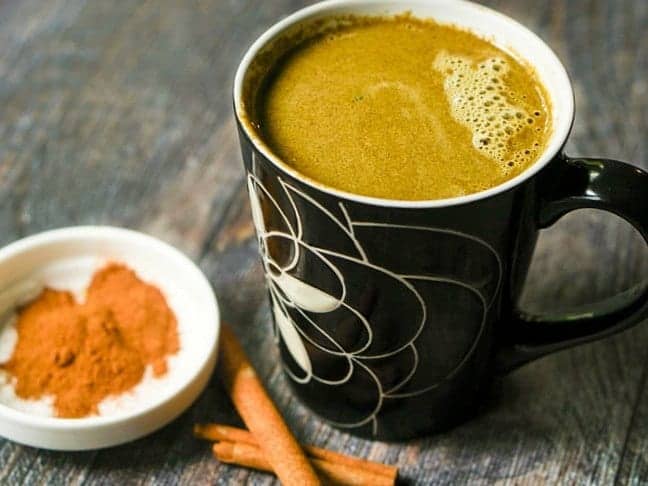
Hot Cinnamon Buttered Matcha A menu that you would not expect to find adding cinnamon powder to green tea is incredibly compatible. Simply add ½ teaspoon of green tea powder + ½ teaspoon of cinnamon powder + 2 teaspoons of butter. Add some sweetness with coconut sugar. Blend 2 teaspoons in 8 ounces of warm water and you have a unique cinnamon-flavored drink to start your morning.
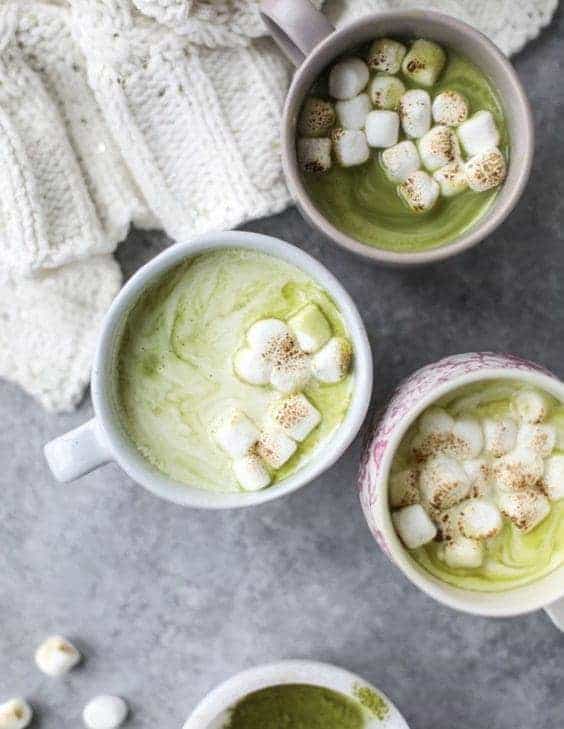
Matcha-Honey Hot Chocolate: Start by heating 2 cups of milk, then add ½ cup of chopped white chocolate. Once the white chocolate has melted, add 1 teaspoon of honey, 1 teaspoon of matcha powder, and 1 teaspoon of salt and mix well. You can add marshmallows as a topping if you like.
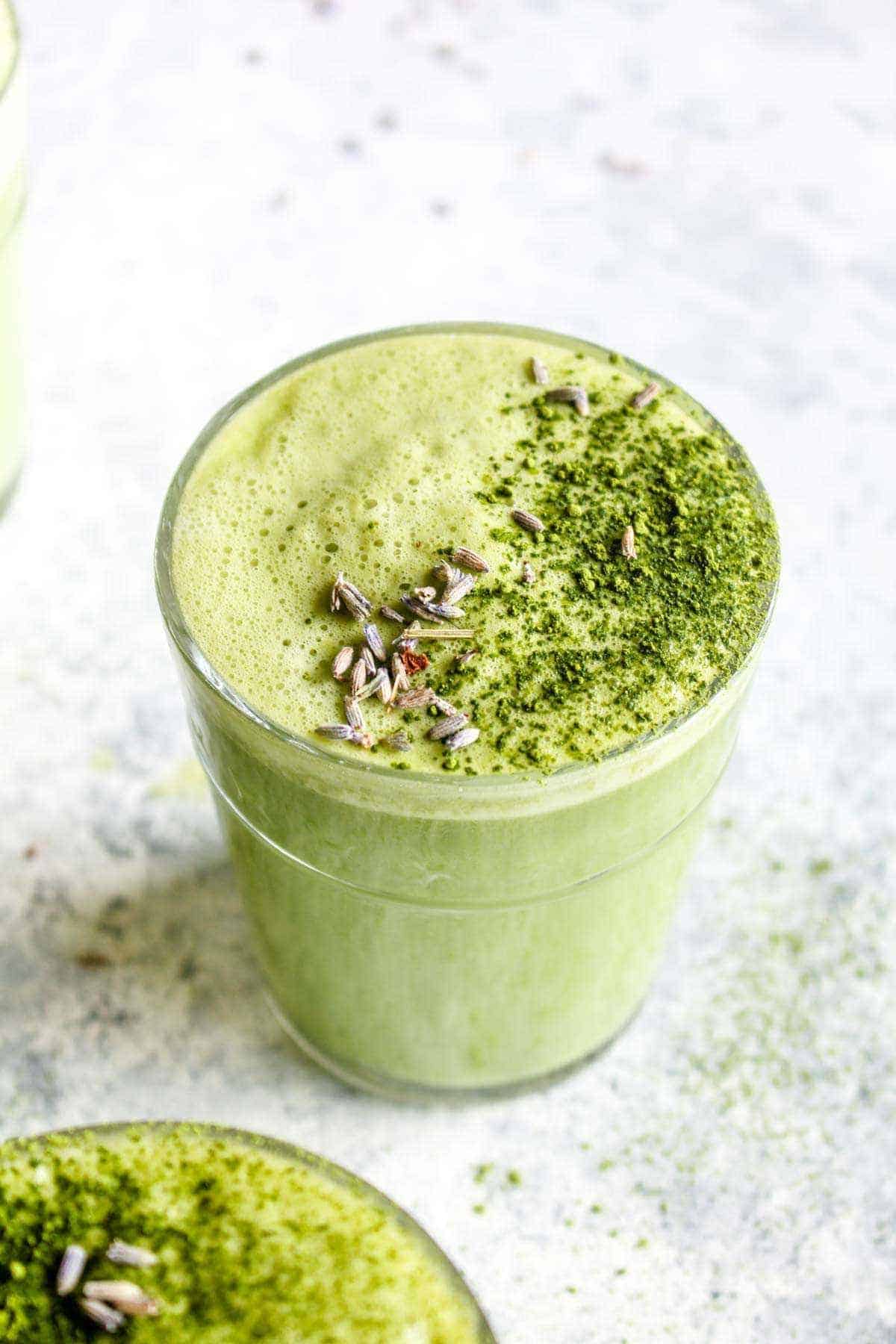
Lavender Matcha Latte made by boiling dried lavender in water for about 5 minutes, then scooping out the lavender flowers. Add 2 teaspoons of dried water and 2 teaspoons of matcha powder to the boiled water. Beat the matcha powder until dissolved. After that, add 2 cups of warm milk, stir well, and decorate with a few dried lavender flowers before serving. It’s a drink that has a truly modern Japanese feel.
Another flower tea menu that girls love is Matcha Rose Latte , which replaces lavender with roses, which gives a different aroma. Some people add a little cinnamon powder to the rose green tea before serving.
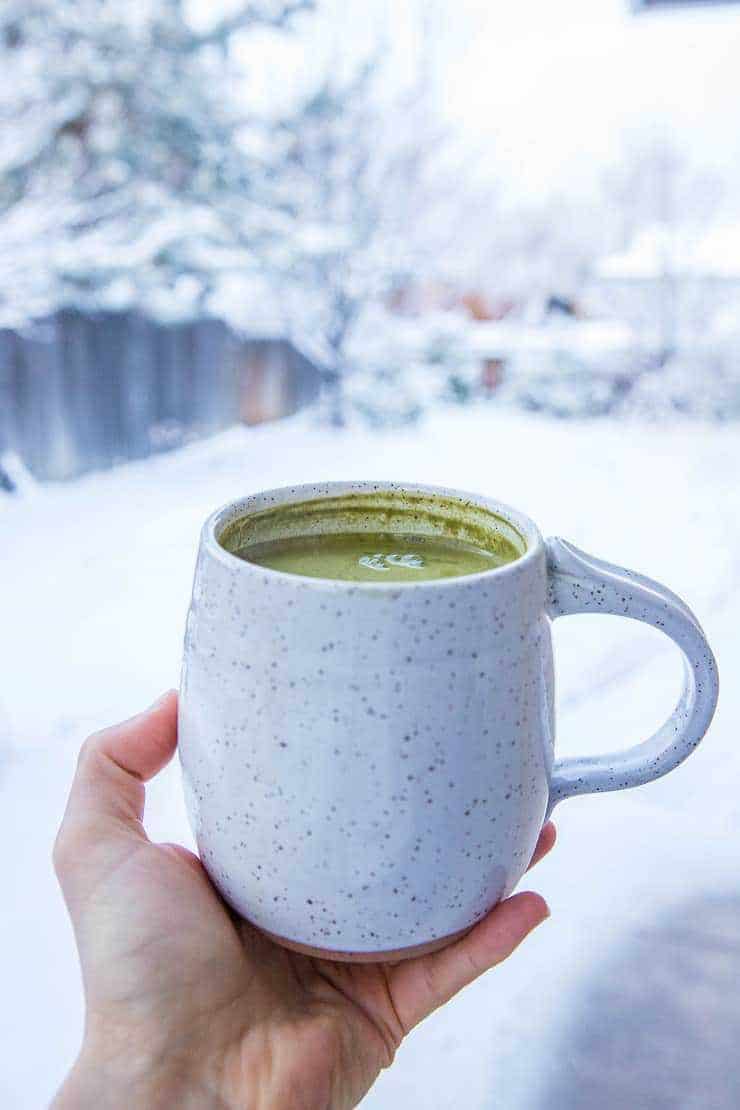
Earl Grey Matcha Latte, a warm tea menu made from 2 bags of Earl Grey tea, boiled in water for about 5-8 minutes, then add ½ teaspoon of matcha powder + a little cinnamon powder + 1 tablespoon of non-dairy creamer, mix together and you’re done. You’ll get a new style of green tea with an English feel.
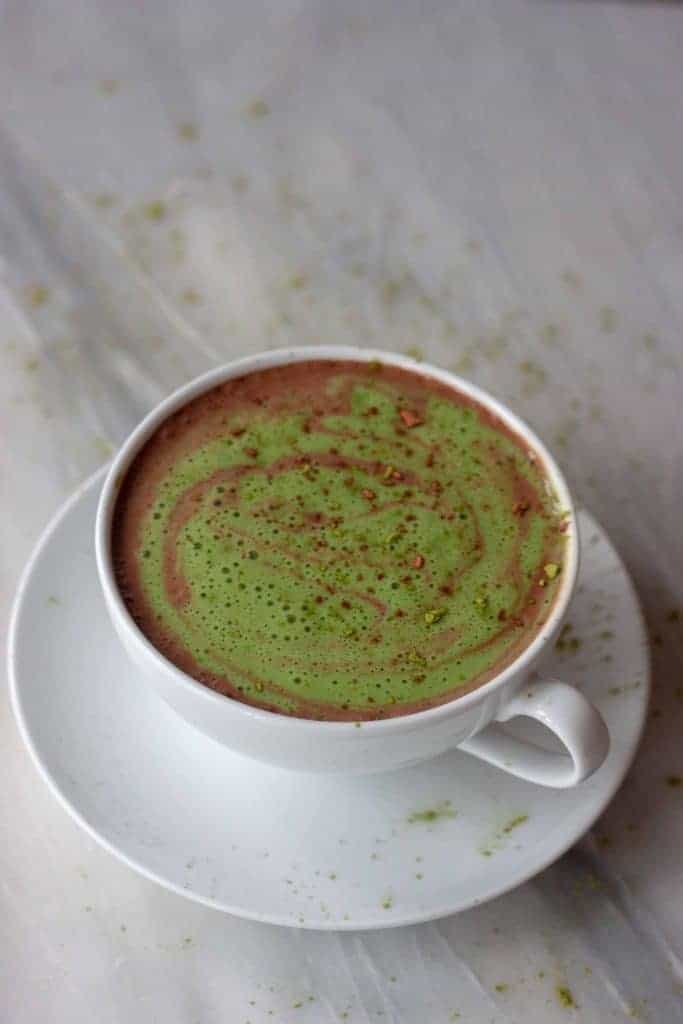
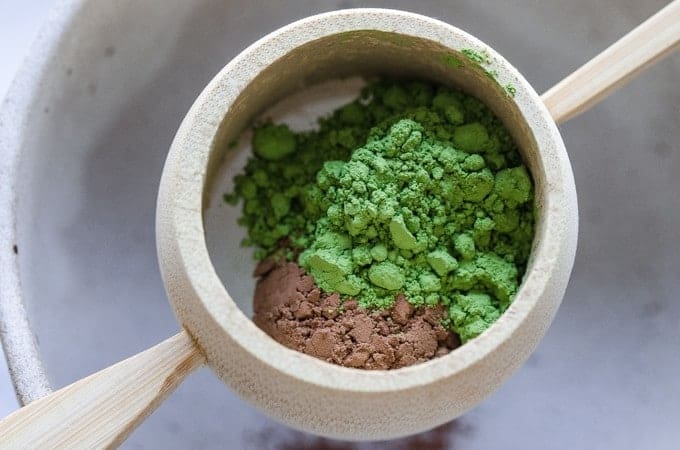
Another warm tea menu that uses cocoa powder as the main ingredient to enhance the flavor is the Matcha Cocoa menu, which mixes 1 ½ teaspoons of matcha powder with 1 teaspoon of cocoa powder in 5 teaspoons of water at a temperature of about 70 degrees, beats to mix well, then adds a little salt and 1 teaspoon of maple syrup, a little vanilla flavor, then slowly adds ¾ cup of warm milk, and it’s done. Some people will serve it with whipped cream to create another step of a rich flavor for this glass of cocoa green tea.
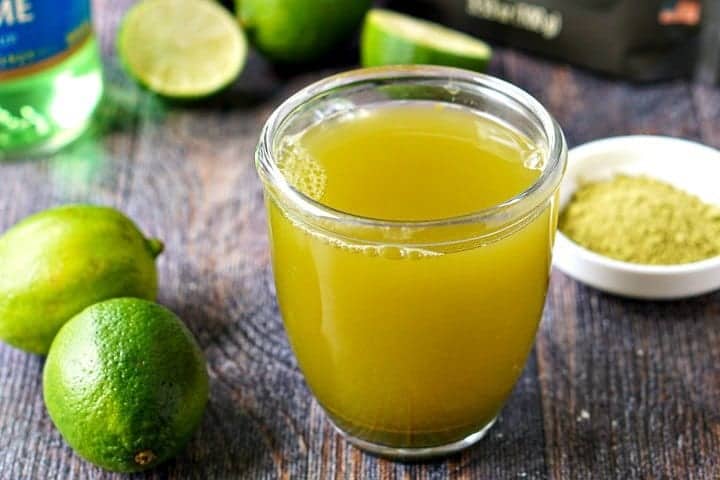
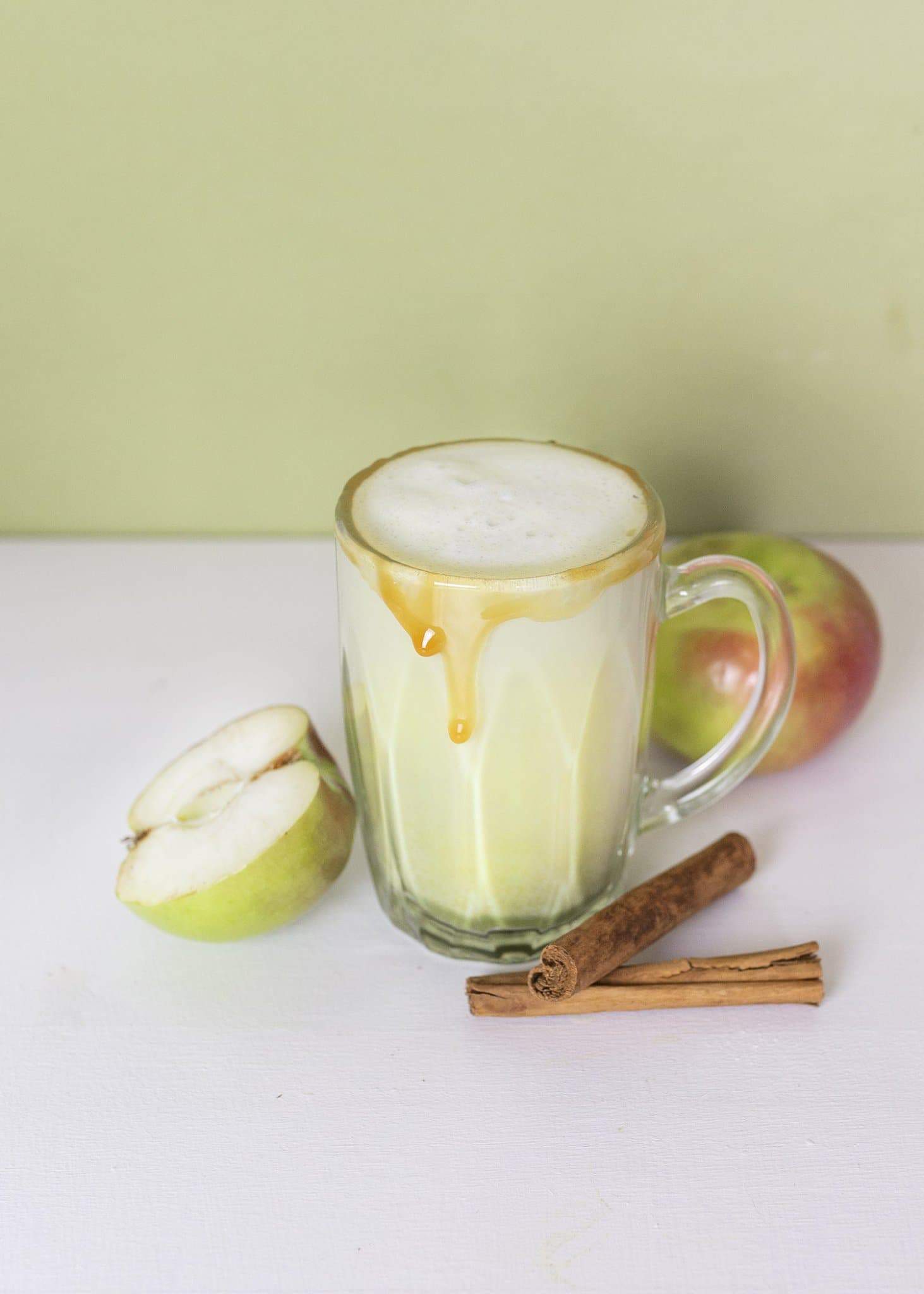
There are many other warm menus that use matcha powder to create unique deliciousness, such as Caramel Apple Matcha Latte or Lemon Matcha Latte. Or if anyone likes cold drinks, we recommend trying them out. ^^
Source
https://tealish.com/blogs/blog/caramel-apple-matcha-latte-recipe
https://www.butteredsideupblog.com/
https://foodbymars.com/matcha-rose-latte-dairy-free-refined-sugar-free/
https://awhiskandtwowands.com/matcha-mocha/
https://www.ohhowcivilized.com
Article from: Fuwafuwa
Add some color to your tea menu for Christmas.
As the end of the year approaches, many restaurants are starting to release new menus to welcome the joyful season, including drinks and bakery items. But if you still don’t know how to create a menu, MATCHAZUKI has collected ideas and recipes for green tea drinks and desserts for green tea lovers to try changing the menu at their restaurants to be more fun.
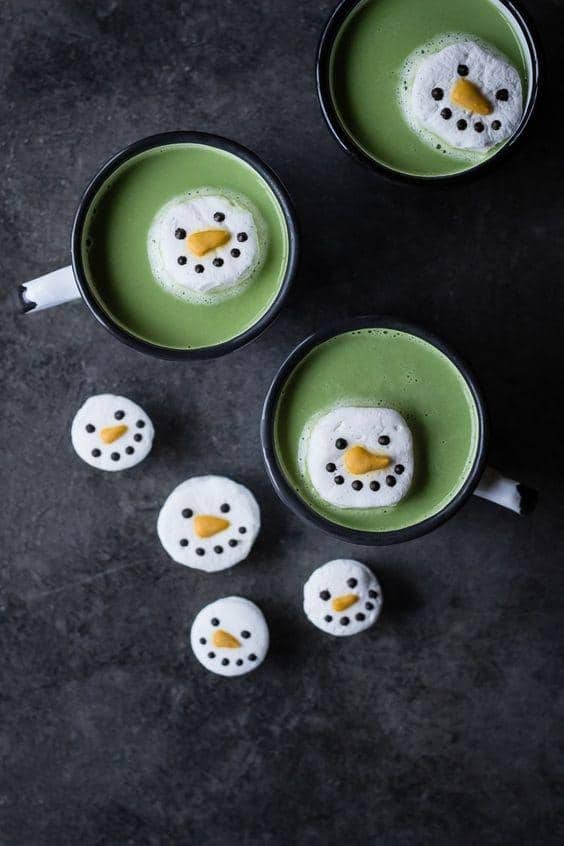
Let’s start with hot matcha latte, a recommended menu of many shops that adds color to the Christmas festival. It’s easy to do by adding cute snowman marshmallows to eat together. The method is not difficult because we start by making square marshmallows according to the marshmallow recipe of the favorite shop. Make it big enough to cut into small rounds. Use a toothpick with a sharp end to break off one end and dip the toothpick into the melted orange white chocolate and draw a nose on the marshmallow. For the eyes, put 2 tablespoons of dark chocolate chips and 1/4 teaspoon of coconut oil in a small dish and microwave for 20 seconds at a time, stirring a little at a time until the dark chocolate is completely melted and smooth. Use a toothpick with a sharp end to dip into the melted dark chocolate and dab it on the eyes and mouth of the snowman. Then let the snowman chocolate set at room temperature before serving with your favorite hot matcha latte.

Next up is the Matcha Cookie Christmas Tree. Start by beating 1 cup unsalted butter, 2 tablespoons matcha powder and 1 ½ cups sugar until fluffy. Add 1 egg yolk and 1 teaspoon vanilla and mix until combined. Sift flour, baking soda and salt together and set aside in another bowl. Add all ingredients to the bowl and mix until combined. Cover the dough and refrigerate for 30 minutes. Preheat oven to 180 degrees. Line a baking tray with baking paper.
Cut dough in half or quarters and roll out to about 1/6 – 1/4 inch thick. Cut out Christmas tree molds and place on prepared baking sheet. Bake each batch for 7 – 9 minutes. Decorate with white chocolate, microwaved for 20 seconds, or mix in a little red chocolate for a different design.
The intensity of the Christmas tree color depends on the amount of matcha powder added. Add some cuteness by tying it with a bow or packing it in a clear plastic bag to show off the cookie pattern.
A technique to make Christmas cookies more cute is when pressing the dough into the shape of a Christmas tree. You can press it into the shape of stars of various sizes so that after baking, you can arrange them in alternating layers, with each layer connected with a little white chocolate. Stick the star on top with almonds and sprinkle a little icing. You’ve got a green tea cookie menu for this Christmas season.
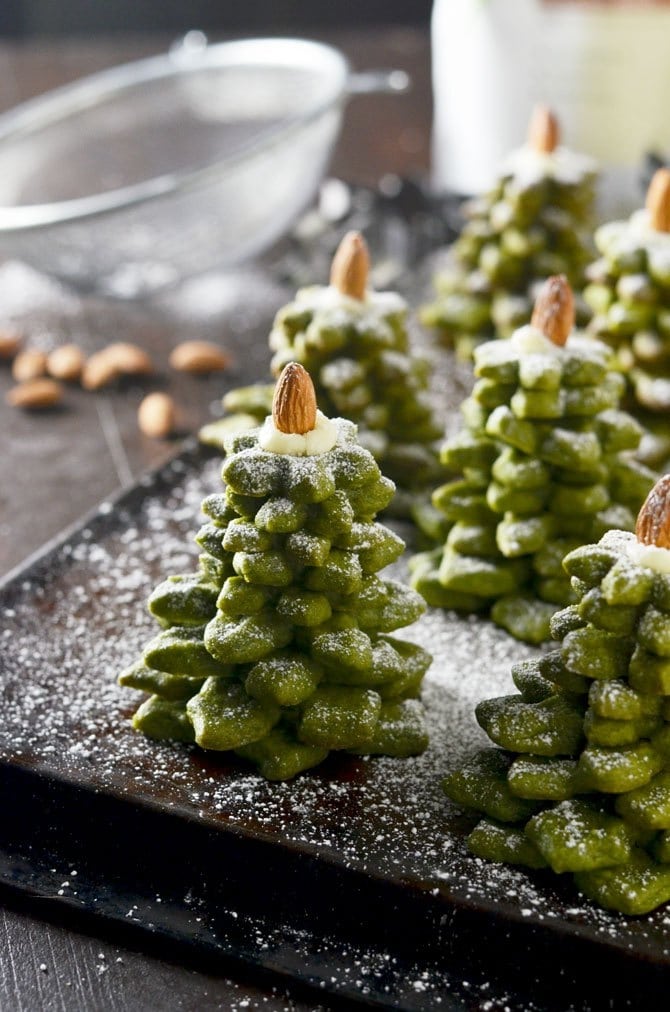
Another menu that just seeing it makes us think of a Christmas tree is Matcha Mont Blanc. You can use the regular Mont Blanc recipe, but change the chestnut cream squeezed on top to matcha cream. Then decorate with colorful icing cookies. It becomes a matcha Mont Blanc that will impress anyone who eats it.
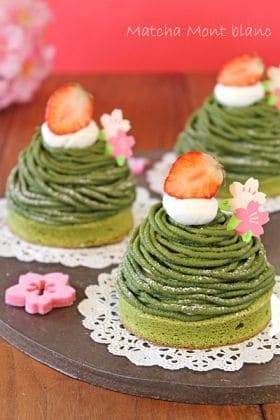
In addition to the tea menu above, which is an example for your tea shop to see the initial idea for modifying the menu, there are many other green tea menus that can be sold during Christmas, such as Matcha Hot Chocolate or Matcha Macaron or Matcha Cake that emphasizes adding red color with strawberries.
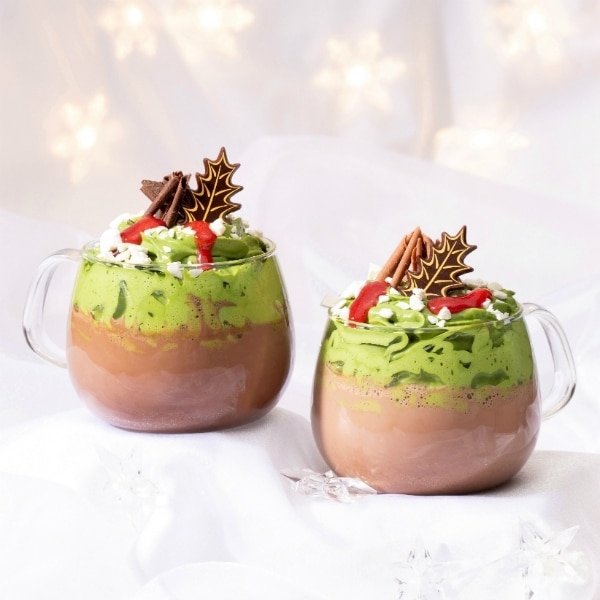
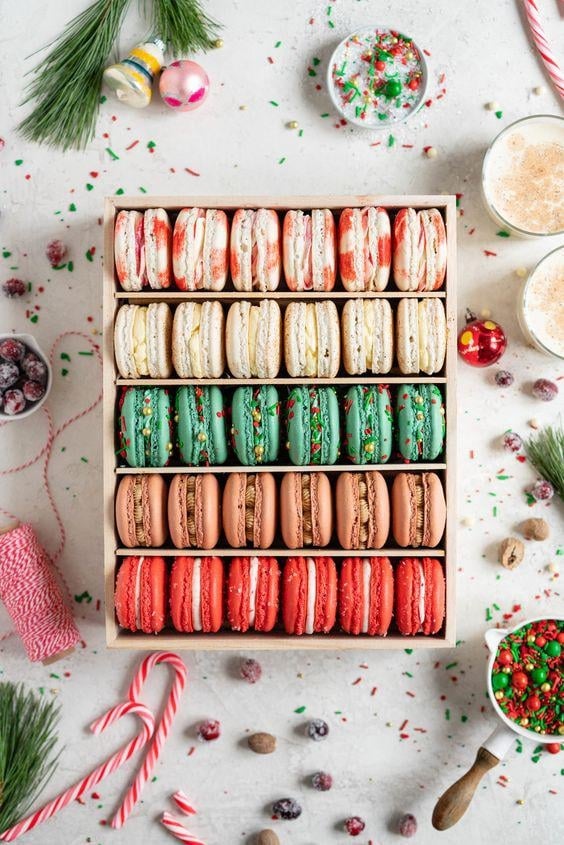
But if you are not good at making desserts that require a lot of techniques, try taking the no-bake green tea dessert menu (see more at shorturl.at/dpDS7) and adjusting it to be Christmas style. It is another interesting idea. Especially if there are new menus and organizing a year-end campaign with interesting promotions or activities, it will help stimulate customers to want to come to the shop even more (see more at shorturl.at/ceqKP). Because it is not necessary that every shop will have new menus during this festival. It may be difficult for some shops to think up new menus all the time. Because according to the Japanese belief, just buying green tea to give to each other during various festivals is considered a blessing for good health (see more at shorturl.at/bcCHK).
Source
https://encha.com/pages/matcha-recipes
https://www.stephaniesuen.com/2018/12/08/mini-matcha-christmas-tree-sugar-cookies/
https://steemit.com/food/@alwayssmile/elegant-noble-french-dessert-mont-blanc
https://hostthetoast.com/matcha-cookie-christmas-tree-stacks/
Article from: Fuwafuwa
Is Mineral Water Suitable for Brewing Tea?
หากพูดถึงน้ำที่ต้องใช้ในการชงชา เชื่อว่าทุกคนต้องนึกถึงอุณหภูมิของน้ำที่ควรใช้ มากกว่าชนิดของน้ำที่ใช้ชงชา เพราะปกติแล้วเราก็จะใช้น้ำสำหรับดื่มทั่วไป อาจจะเป็นน้ำขวดธรรมดาแบบที่วางขายทั่วไป นำมาต้มให้เดือดก็เป็นอันใช้ได้ แต่บางคนอาจจะสงสัยว่า แล้วน้ำแร่สามรถใช้ชงชาได้มั้ย? น้ำแร่ได้ชื่อว่าเป็นน้ำที่มีแร่ธาตุอยู่มาก หากเอามาชงชาแล้ว จะได้ชาที่ยิ่งคุณภาพดีจริงรึเปล่า??
น้ำแร่ มี 2 ชนิด แบ่งชนิดตามปริมาณของแร่ธาตุแมกนีเซียมและแคลเซียมที่พบในน้ำ ซึ่งถ้ามีปริมาณของแร่ธาตุสูง จะเรียกว่า “น้ำกระด้าง” (Hard Water)เป็นน้ำที่มีหินปูนและแมกนีเซียมละลายอยู่ด้วยค่อนข้างมาก แต่ถ้ามีปริมาณของแร่ธาตุต่ำ ก็จะเรียกว่า “น้ำอ่อน” (Soft Water)ส่วนมากน้ำแร่ นำเข้าจากต่างประเทศจะเป็นน้ำแร่ธรรมชาติแบบน้ำกระด้าง แต่ถ้าในไทยจะเป็นน้ำแร่ธรรมชาติแบบน้ำอ่อน โดยหลักแล้วน้ำทั้ง 2 ชนิด สามารถชงชาได้รสชาติดีเหมือนกัน แต่กลิ่น สีจะแตกต่างกัน
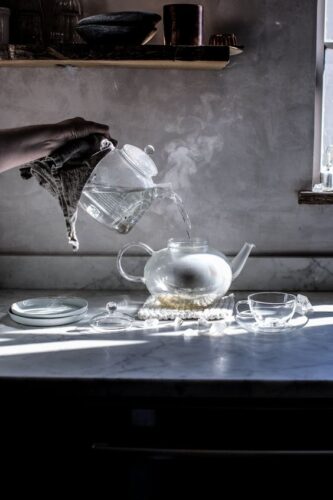
ในการชงชา นิยมใช้น้ำอ่อนมากกว่าน้ำกระด้าง เพราะในน้ำมีปริมาณแร่ธาตุน้อย ชาที่ได้จึงมีสีเข้ม รสชาติเข้มกลมกล่อมกว่า ทำให้สามารถดื่มด่ำกับรสชาติของชาได้มากที่สุด ตรงกันข้ามกับการใช้น้ำกระด้าง ซึ่งรสชาติของแร่ธาตุจะไปกลบรสชาติของชา ทำให้เวลาดื่ม นอกจากจะไม่ได้ดื่มด่ำกับรสชาติของชาอย่างเต็มที่แล้ว และอาจมีกลิ่นคล้ายๆกับโลหะเจืออยู่ในน้ำชาอีกด้วย รสชาติและกลิ่นหอมจะอ่อนๆ สีน้ำชาจางๆ แต่ก็ไม่ใช่ว่าจะไม่สามารถใช้น้ำกระด้างในการชงชาได้เลย เพราะสุนทรียของการดื่มชาของแต่ละคนแตกต่างกันไปตามความชอบนั่นเอง
อย่างไรก็ตามก็มีบางคนที่เน้นความสะดวก นำน้ำประปามาต้มแล้วเอามาใช้ชงชาดื่ม ซึ่งน้ำต้มที่ได้จะมีคลอรีนที่ใช้สำหรับฆ่าเชื้อโรคในน้ำละลายปนอยู่ด้วย จะมีกลิ่นอื่นเจือปนอยู่ ถ้าอยากจะใช้น้ำประปาไปต้มชงชา ควรต้มน้ำในภาชนะที่ไม่มีฝาปิดและควรเพิ่มเวลาต้ม ประมาณ 3-5 นาที เพื่อให้กลิ่นคลอรีนระเหยหมดไป
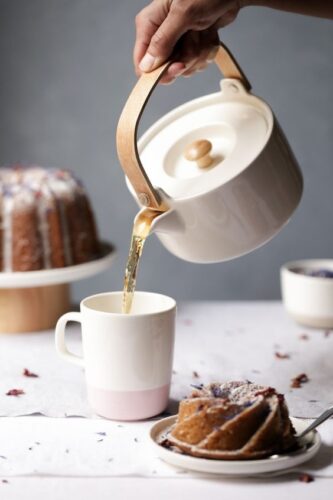
ดังนั้นในการชงชาสามารถใช้น้ำแร่ชงได้ และสามารถใช้น้ำดื่มทั่วไปที่ สด ใหม่ สะอาด บริสุทธิ์ กล่าวคือ น้ำที่ไม่มีกลิ่นอื่นเจือปน ไม่ใช้สารเคมีในการปรับคุณภาพ อีกทั้งไม่ใช่น้ำที่ผ่านการต้มมาแล้วหลายครั้ง เพราะน้ำต้มที่ผ่านการต้อมหลายครั้งจะมีออกซิเจนน้อย หากนำมาชงชาจะทำให้รสชาติชาจืดชืดไป ขาดความนุ่ม และความลึก เป็นไปได้ ควรใช้น้ำที่มีค่าน้ำเป็นกลาง (PH7)ดังนั้นจะเหมาะที่สุด
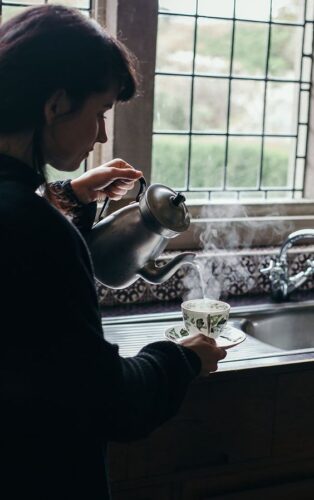
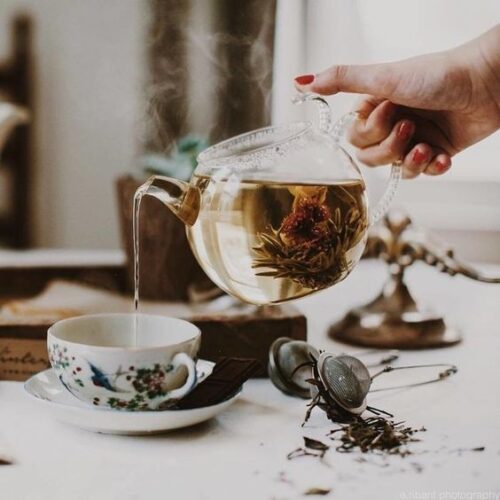
ทั้งนี้การใส่ใจกับคุณภาพน้ำอย่งเดียวไม่ได้ส่งผลต่อรสชาติของชา 100% แต่ความอร่อย รสชาติอูมามิของชา ยังต้องคำนึงถึงอุณหภูมิของน้ำ ระยะเวลาที่ใช้ชง คุณภาพใบชา และยังรวมถึงเรื่องของภาชนะที่ใช้ในการชงชาอีกด้วย
ที่มา
บทความจาก : Fuwafuwa
3 Japanese snacks that are popular with green tea
Many people already know that Japanese people like to eat green tea with Japanese sweets, or what is called wagashi. Although there are many other sweets that can be eaten with green tea in the tea ceremony, the sweets that are ranked as popular with people who drink tea and are well known among Thai people include:
Number 1 is Daifuku, a soft and chewy mochi dessert that comes with a variety of fillings, including green tea lava, green tea red bean, and some even add fruit to enhance the flavor. The dessert is sweet and served with hot green tea, creating a perfect combination of deliciousness.
For those who want to try making their own daifuku and serve it with tea at the restaurant, adding a touch of Japanese flair to the menu is easy to do. You can also customize the dough to your liking, such as fugu or filling.
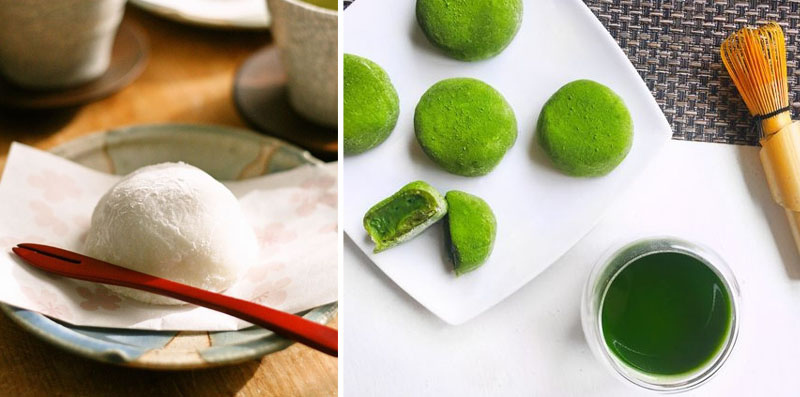
Green tea strawberry daifuku menu
- 100 grams of glutinous rice flour
- 20 grams of tapioca flour (for making dusting powder)
- 10 grams of matcha powder
- 50 grams of granulated sugar
- 150 ml. plain water
- 200 grams of ready-made white bean paste + tea powder
- Green 5 grams
- Strawberry
method
- Mix glutinous rice flour, matcha powder, and sugar in a microwavable container. Gradually add water and mix until the flour is no longer lumpy and the consistency is thick.
- Put the flour mixture in the microwave, covered with plastic wrap or in a covered container to prevent the surface from drying out. Microwave on high for 3 minutes, stirring every 1 minute. Observe the flour. If it is cooked, it will turn into a clear flour and will form into a lump.
- Take the cooked flour and mix it with flour. Divide it into equal parts. Flatten the dough into a round sheet. Add the white bean filling mixed with green tea powder to form a single texture that wraps the strawberries. Shape it into a round ball. Mix it with flour to prevent the daifuku from sticking together. It’s done.
Typically, when serving daifuku, a small stick, called a kuro mochi (黒文字), symbolizes that the dessert should be cut into bite-sized pieces before eating. Usually, the pieces are not very large and can be cut into about 3-4 pieces.
Next up is sembei, a crispy rice snack that comes in a variety of shapes, sizes, and flavors. While most commonly salty (a flavor derived from soy sauce), sweet versions can also be found. Sembei are most commonly eaten with green tea, as a snack, and given to guests at home. They are typically baked or grilled in the traditional charcoal manner. During cooking, the sembei are brushed with a seasoning sauce, typically made from soy sauce and mirin. They are then wrapped in seaweed and seasoned with salt. Unlike daifuku, sembei are served with tea without the kuromochi sticks. It is generally considered polite to eat them with your hands.
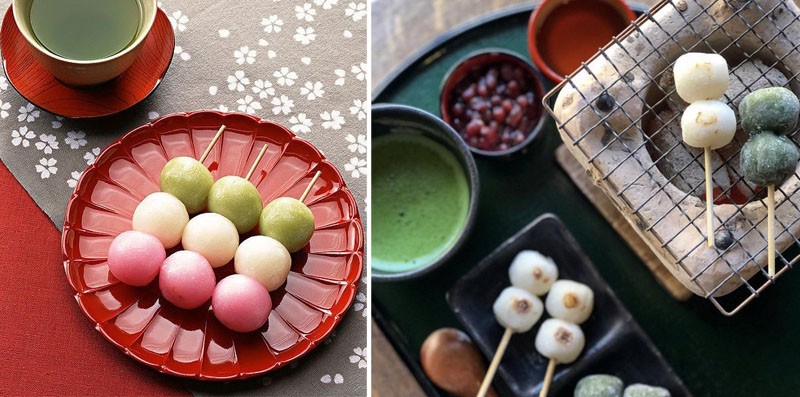
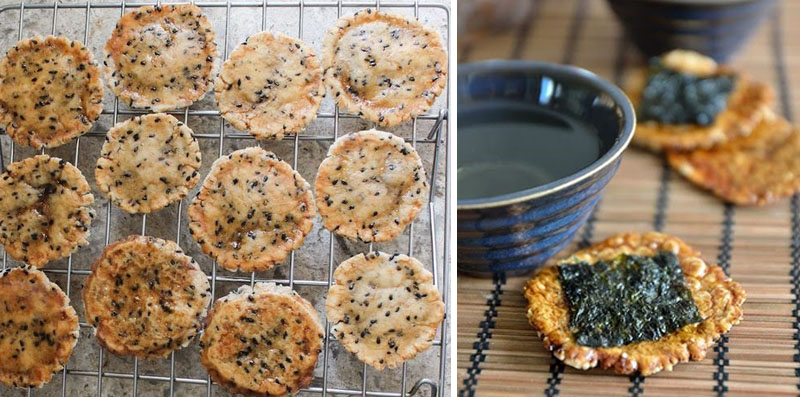
If you’d like to try making your own dango, you can do so at the shop. The method is similar to making bua loi in Thailand.
Ingredients: 250 grams of white tofu, rice flour (or mochi flour) + 200 grams of sugar.
Easy to make: First, knead the tofu and rice flour together with your hands until the dough is just the right consistency—not too soft or too hard. Then, shape it into balls. Boil a large pot of water until it boils, then add the dango balls. Continue to boil until they float to the surface. Once they float to the surface, boil for another 2-3 minutes and remove from the water and set aside on a paper plate. Skewer them and enjoy with the sauce or grill them gently, as desired. Serve with the shop’s hot green tea. We guarantee that every visitor will feel like they’ve been transported to Japan.
Source
https://www.pinterest.com/pin/325807354293426536/
https://moichizen.exblog.jp/13348925/
https://www.pinterest.com/pin/14707136267674817/
https://www.japancentre.com/en/recipes/1669-matcha-ganache-filled-strawberry-daifuku
By : Contrary To Popular Belief
Sweetness and tea menu
There’s no denying that the easy-to-drink tea beverage that’s popular among Thais isn’t just plain tea. It’s tea that’s sweetened with sugar and honey, and enhanced with milk for a more balanced flavor. Bottled teas sold in convenience stores, such as ready-to-drink green tea lattes, even those labeled as pure green tea, often contain significant amounts of sugar. However, it’s undeniable that this sweetness enhances the taste of your favorite tea and refreshes your body.
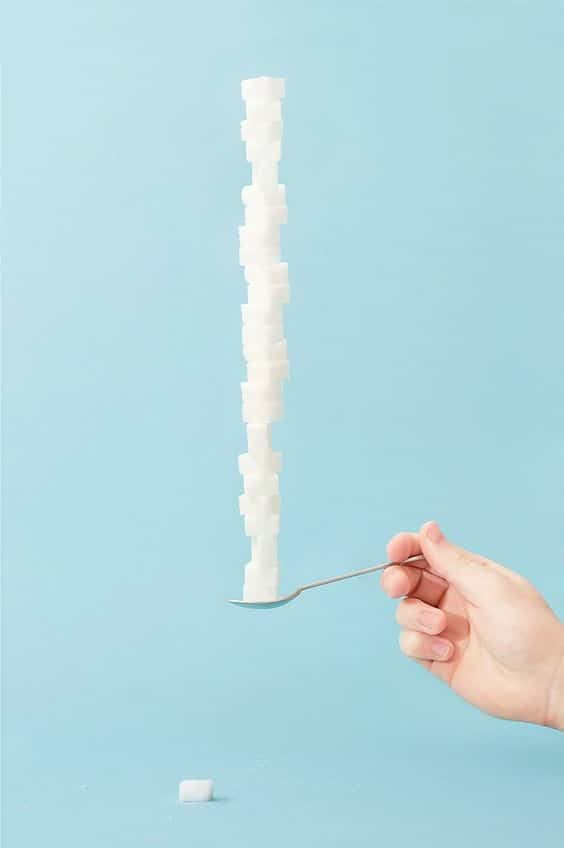
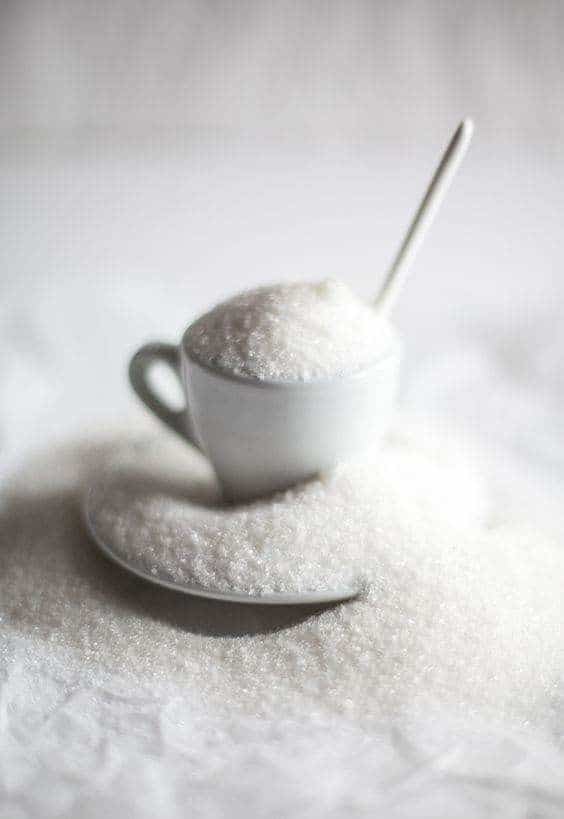
Sweetness and tea menus are like a pair, but we can choose what to give the sweetness from besides sugar.
1. Syrup is obtained by simmering sugar and water over medium heat. It is clear in color and is often used to pour over Thai desserts with coconut milk. It is also used in coffee shops to add sweetness to drinks like tea and coffee. Bartenders also use it to mix in cocktails. Syrup can mean dissolving sugar in water to create various levels of sweetness. It is the most popular sweetener in the market, whether in cafes or tea shops, because it is convenient to brew and easy to store. However, be careful that pressing just one pump of syrup, which may seem like a small amount, but gives a surprisingly high amount of sweetness, is therefore not a good choice for health-conscious people.
2. Maple syrup is made from maple sap and boiled until it becomes a concentrated syrup. It is often used as a substitute for honey on desserts. However, pure maple syrup is rare. What we often see is artificial maple-flavored syrup. If you want to use it in green tea, the proportions are as follows: 4 cups of milk + 1 tablespoon of green tea powder + 1 tablespoon of maple syrup. Boil them together and pour foam over it. The taste is not much different from using sugar, except that you will get a different aroma and it is a lighter sweetness, not as sharp as syrup.
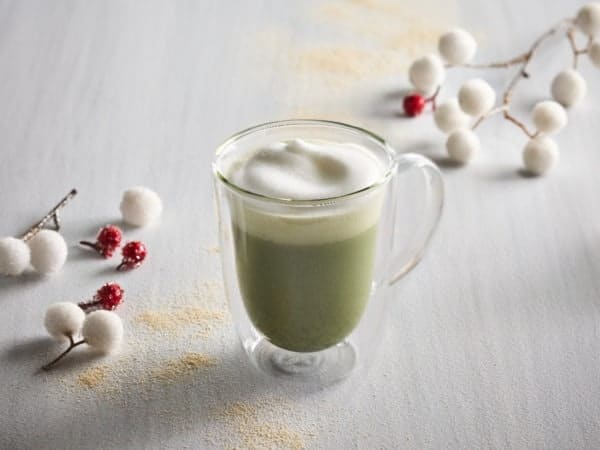
3. Honey: Naturally sweet, it’s just as sweet as sugar and contains protein, providing energy that keeps you energized. It also contains vitamins and minerals. However, consuming too much can lead to obesity. Honey contains glucose and fructose, which are single-molecule sugars that the body can absorb and use. Honey also contains antioxidants, which help slow down cell degeneration and improve the body’s immune system. Importantly, honey also provides sweetness and a unique aroma.
If you try making it with this recipe, it will help your tea menu stand out with the sweetness of honey. Or you can elevate the menu by using coconut milk instead of cow’s milk to make it suitable for people who are allergic to cow’s milk. Take 1 teaspoon of matcha powder + 1/2 cup of hot water + 1 cup of coconut milk + 1 teaspoon of honey.
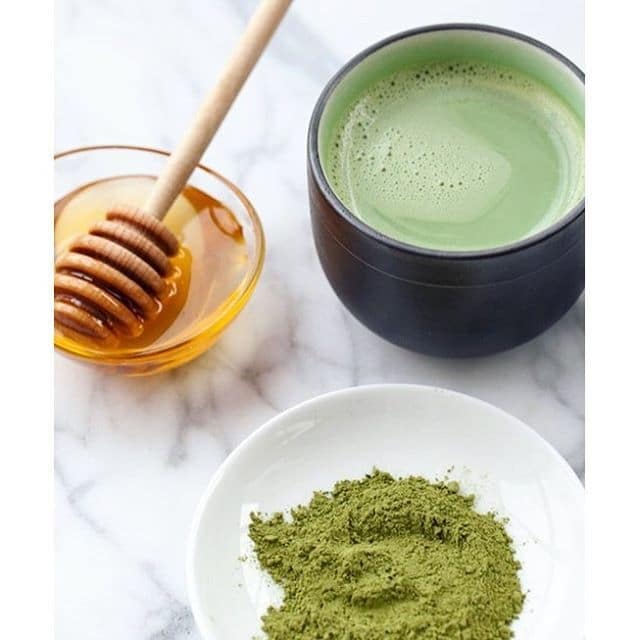
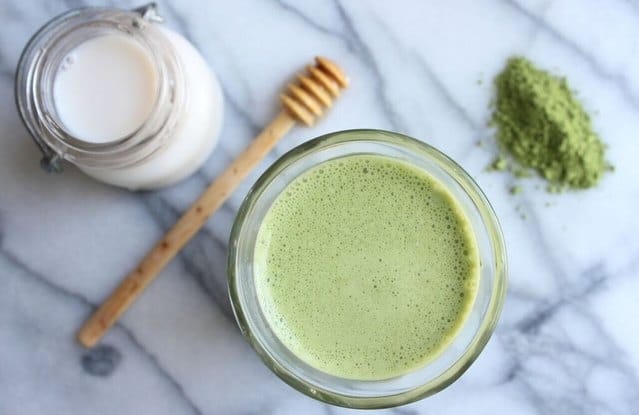
4. Coconut sugar is a great substitute for sugar because it’s a natural sugar that hasn’t been processed in many steps. Its color is similar to brown sugar, but its texture is coarser. It’s packed with nutrients that are beneficial to the body and won’t raise blood sugar levels. Before using it in cooking, it should be mixed with liquid. If using it to make a green tea latte, use a ratio of ½ teaspoon matcha powder + 2 teaspoons coconut sugar + 1 teaspoon coconut butter + 10 ounces of hot water. Mix together. However, you can skip adding butter if you prefer, as this recipe requires butter to give the green tea latte a rich flavor, unlike some recipes that use cream or condensed milk.
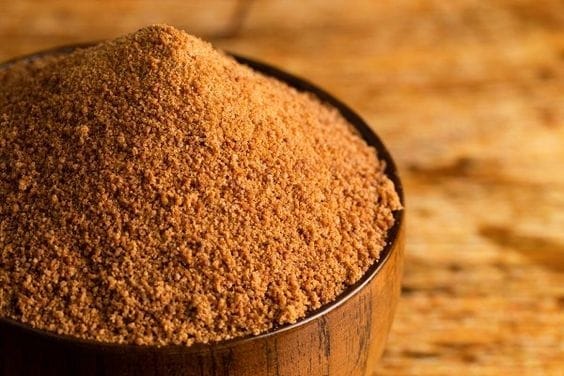
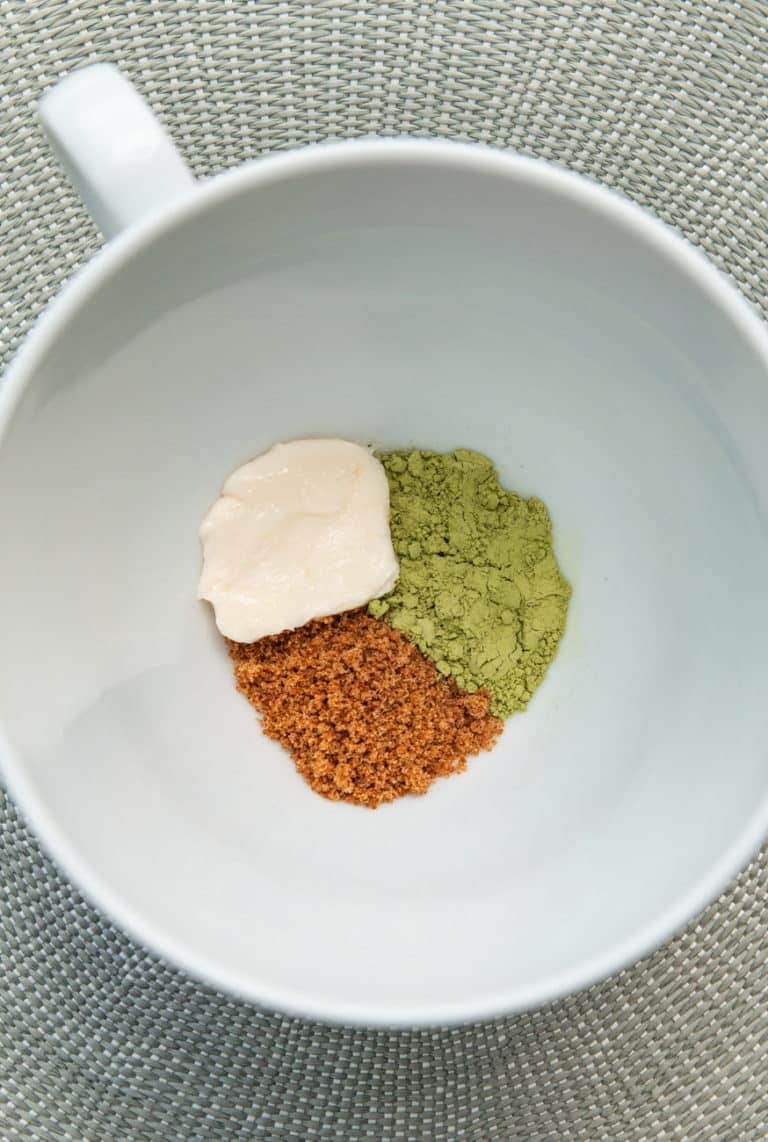
In addition to the above sweeteners, there are other options for tea, such as sweetened condensed milk, which provides a rich, creamy sweetness that’s a favorite among Thais, or brown sugar, simmered into a syrup that gives it a unique Japanese flavor and aroma . Stevia is considered the most natural and effective sugar substitute, as it’s 300 times sweeter than sugar yet low in calories. Stevia can be used in a variety of dishes or mixed with tea or coffee. It’s common to find beverage shops using stevia as a selling point, assuring customers that it won’t easily gain weight. However, it must be consumed in moderation.
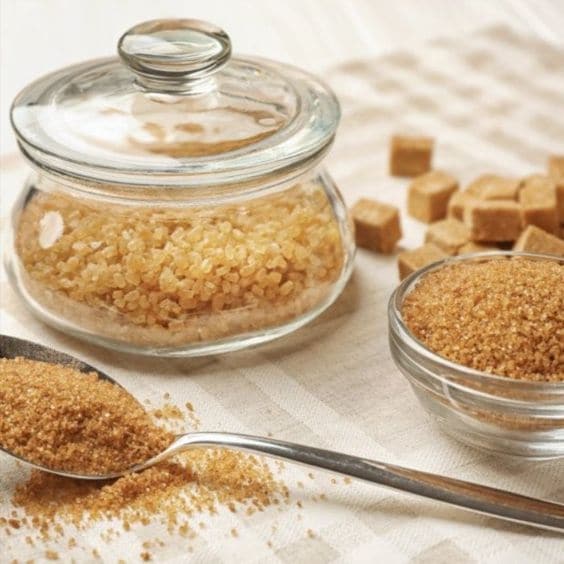
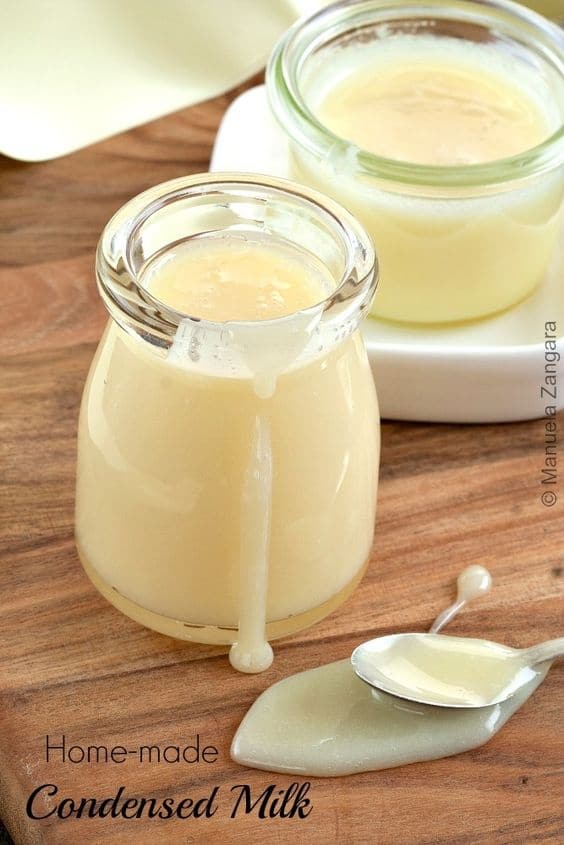
Choose the sweetness of your tea menu to suit your shop’s style. Create a unique tea menu that stands out from other shops easily with small details that many shops may overlook.
Source: http://www.byrdie.com/weight-loss-tips?utm_campaign=article-share&utm_source=social-pinterest-button&utm_medium=earned-social
https://www.livestrong.com/recipes/matcha-almond-milk-honey/
https://maplefromquebec.ca/recipes/maple-matcha-tea-latte/
https://www.cleaneatingkitchen.com/dairy-free-green-tea-matcha-latte/
Article from: Fuwafuwa

